PUBLIC SAFETY COMMITTEE MINUTES – AUGUST 9, 2011
PATRICK KILMARTIN, CHAIRMAN
MEMBERS PRESENT: Mr. Dougherty, Ms. Williams, *Mr. Masterpole
MEMBERS ABSENT: Mr. Meyer
ALSO PRESENT: See attached list
Chairman Kilmartin called the meeting to order at 9:01 a.m. A motion was made by Ms. Williams, seconded by Mr. Dougherty to waive the reading and approve the minutes of proceedings from the previous committee meeting. MOTION CARRIED.
1. EMERGENCY MANAGEMENT: Kevin Wisely, Commissioner
a. Amending the 2011 County Budget to Accept Homeland Security Funds From the State Homeland Security Grant Program for the Onondaga County Department of Emergency Management, and Authorizing the County Executive to Enter into Contracts to Implement this Resolution ($727,388)
Mr. Wisely provided a revised program and financial summary sheet for the funding allocation, due a clerical error. In response to Chairman Kilmartin, Mr. Wisely confirmed the only change was the second line item funding amount formerly listed as $427,173, should be $460,208.
| Project Priority |
SHSP FFY 2010 |
Funding allocation |
Critical infrastructure protection |
Continue to harden critical infrastructure through improved surveillance capability – fixed and portable. |
$78,000 |
Emergency preparedness planning & incident management |
Update, enhance and develop preparedness plans; expand incident management through training, exercise and field credentialing.
|
$460,208 |
Interoperable communications |
Upgrade and improve interoperable communications for mobile command unit and other field operations. |
$30,000 |
Emergency responder training, exercising and equipping |
Repair/replace expired CBRNE response equipment, improve responder tools and personal protective equipment. |
$92,500 |
Public health preparedness |
Continue to test and improve response plans, and interoperability among public health agencies. |
$66,680 |
- SHSP grant has been awarded to Onondaga County since its inception in 2004
- Assist with planning and preparedness for chemical, biological, radiological and nuclear events, critical infrastructure protections and interoperable communications
- Funds have been used year to year to build preparedness, look to continue with these appropriations to prepare Onondaga, Madison and Oswego Counties
- Onondaga County will act as the conduit for the grant
- Additional towns and villages within Onondaga County will receive benefit through preparedness planning of comprehensive emergency response plans
- No new hires or allocation for overtime via this grant
Mr. Dougherty asked for specific examples of citizen preparedness. Mr. Wisely responded that this is something new that they will be moving into. They have done some baseline things. They are currently working on putting together something for September; National Preparedness Month. They will be preparing information on how to prepare, things to have in your homes, how to respond, etc. They have discussed potential public service announcements via radio, possible citizen emergency response teams, preparing people to assist in the event of a major incident in Onondaga County.
Mr. Dougherty asked for additional specific examples of items, other than interoperable communications. Mr. Wisely responded that they have a contract in place for emergency preparedness planning and incident management and would like to continue to keep this in place. They prepare comprehensive plans to help insure that all critical infrastructures are identified; the right tools and mechanisms are in place, as well as training. Training is provided for both career and volunteer responders. The next level in planning is to assist in developing templates for towns and villages to begin developing their own emergency plan.
Mr. Dougherty stated state and federal personnel would have to be involved in any radiological or nuclear event. Mr. Wisely agreed, adding we would be the initial responders should an event occur. Training is necessary, as well as the right equipment, in order to detect and monitor the situation so that the responders and citizens remain save. This would be a multijurisdictional operation.
In response to Mr. Dougherty, Mr. Wisely stated that response communication is built into planning. A large part of this goes into exercises. A large scale exercise will be conducted in 2012 involving multiple counties and agencies. Utilizing the plan, equipment and training they will have a baseline as to how well they have developed to this point.
In response to Chair Kilmartin, Mr. Wisely stated that some of the equipment being purchased is actual detection equipment, used to monitor a particular type of release. Some of the equipment is software based, assisting in determining the eventuality. In reference to interoperable communications, they continually try to upgrade their system making sure that they are able to communicate with multiple agencies. They are involved with fringed departments in Cayuga and Cortland Counties and want to be able to have the ability for interoperable communications with them and others they may want future communications with.
Mr. Dougherty stated that chemical and biological equipment used to detect and monitor is expensive, maintenance intensive and expires. The detectors are perishable. He asked how long the equipment that they are purchasing will last. Mr. Wisely responded that it all varies depending on the type of equipment. Some things are replaced on an annual basis; meters have to be updated and refreshed. Some of the more technical meters will last longer, but they must be calibrated and maintained. Some of the equipment is replacements for outdated products. Technology continues to improve, allowing for longer shelf life of the newer equipment.
Mr. Dougherty stated that we are fortunate that these types of situations don’t happen very often, yet it is a double edged sword. We don’t want to be caught without the equipment, however it is tough to allocate money to maintain or replace something that we only need every ten years. He would hate to see us buy sophisticated equipment on a grant such as this, to find that it cost us additional money yearly. Mr. Wisely responded that they really look at this; what is specific, what is something that we can use during the exercises to formularize the trainee with the product. Not only does the equipment become outdated, our trained personnel do also. We are dealing with a large volunteer operation; there is a lot of turnover. The planning and preparedness goes to assuring that we have the right tools and the right people, trained to operate those tools going forward.
In answer to Mr. Dougherty, Mr. Wisely confirmed funds are allocated in the grant for maintenance of the detecting and monitoring devises.
A motion was made by Mr. Dougherty, seconded by Ms. Williams to approve this item. Passed unanimously; MOTION CARRIED.
*Mr. Masterpole arrived at the meeting.
2. SHERIFF: John Balloni, Chief Civil Development
a. Amending the 2011 County Budget to Accept State Homeland Security Funds for the Onondaga County Sheriff’s Office and Authorizing the County Executive to Enter into Contracts to implement this Resolution ($281,612)
- Federal money through State Homeland Security; Onondaga County acts as the pass through, disbursing funds
- Preplanned disbursement, Chiefs or designee get together and determine what they need and the training necessary; some direction in the grant for specific training and equipment along the lines of threats foreseen by the federal government
BUDGET:
Agency |
Project |
Budget |
Camillus |
4 Mobile Computer Terminals (MCT’s) & 1 Mobile Radio For Commercial Vehicle Enforcement SUV. |
$ 17,200 |
Cicero |
2 Portable Radios. |
6,600 |
Dewitt |
17 Air Card Subscriptions, 1 Portable Rack Battery Charger For SWAT Response Vehicle, 6 Portable Radio Batteries, 6 Ballistic Vests, and 3 SWAT Team Members To Attend Training. |
43,009 |
East Syracuse |
1 Portable License Plate Reader. |
13,925 |
Liverpool |
1 Access Card System and 2 Cypher Door Locks. |
6,450 |
Manlius |
1 Cell Phone Extraction Kit, 6 Ballistic Vests, and 3 SWAT Team Members To Attend Training. |
38,526 |
Marcellus |
4 Security Doors, 4 Combination Locks, and 1 Access Card System. |
8,500 |
Sheriff |
Instructors To Host Hostage Rescue School For All Law Enforcement Agencies, Host Interagency SWAT Training, 4 Ballistic Shields, 2 Rifle-Rated Vests. |
77,000 |
Skaneateles |
Expand IP Camera Project To Include Water Treatment Plant, DPW Facility, And Police Station. |
6,000 |
Syracuse |
6 IP Cameras, Training, & Software For Digital Video Surveillance Project Expansion. |
64,402 |
Total Grant: |
|
$281,612 |
- Minimal expense to the County, other than the training, mainly paperwork
- Funding for training overtime reimbursement; difficult to do this type of training without backfilling with people on overtime or sending them to do the training, either way overtime is involved, pays for fringe benefits associated with the overtime
- Sheriff’s department will be acting as trainers and trainees, depending on the program, they will coordinate and be involved in some SWAT training, some outside hired trainers will be brought in for some of programs
- Basetime pay will not be reimbursed for trainers or trainees, if there is a necessity for overtime reimbursed for overtime and all fringe benefits
- Expenditures will not be until late 2011 or early 2012 at best
Chair Kilmartin stated that he believes there is a requirement for the Sheriff’s office to secure training to remain updated and asked if this would cover the cost for the required training. Chief Balloni responded, “Yes”. This is training that they would be doing locally anyway. This provides an outside source for the training funding; a savings to the local taxpayer.
Mr. Masterpole asked if the 6 IP cameras listed for Syracuse were reimbursement for the ones placed in the neighborhood on the near west side. Chief Balloni responded that they were not a reimbursement, 6 additional cameras. They are the same type of camera, though he does not know the City’s intent for usage.
A motion was made by Mr. Masterpole to approve this item.
Mr. Dougherty questioned what a cell phone extraction kit was. Chief Balloni responded that this was a good question; he does not know. People that are experts in this area specifically put in request for items they want. He hesitates to speculate. Chief Balloni will get back to the committee with the answer.
Seconded by Mr. Dougherty. Passed unanimously; MOTION CARRIED.
b. INFORMATIONAL: Air One
- July 8, 2011 received letter stating they would receive a response in regards to the tax exempt status request within 90 days
- July 12, 2011 received approval for 501C3 tax exempt charitable organization
- First 250 letters sent out
- Have several thousand dollars in established bank account
- Actively seeking a naming grant for the ship, have had a conference call with one major corporation, still looking for other interested corporations, appreciate any ideas, would like to name appropriately
- First poker run took place in June or July, took in over $7,000 with $4,000 in expenses, ordered T-shirts for several years with thoughts of this being an ongoing event
- Noted first year for the event; Motorcycles for Babies just raised $49,500, potential for a large event, public relations work needs to be done
- Profits of Poker run will be added to bank account allowing for foundation working funds
Chairman Kilmartin asked if there was a business plan created or contemplated for the foundation; what the projected revenue is, how you are going to identify potential donors of all sizes, what the source is, what the uses of the funds might be. Chief Balloni responded that all these things are still under discussion. All the funds coming in will be used to offset the costs of keeping the ship flying; this is part of the charter. Beyond this, they are looking at how the other foundations operate in terms of gold and silver memberships. They are in the learning stages of the foundation. They continue to study what other organizations are doing; how they are successful. Foundations can generate a lot of revenue; looking to make their foundation a success.
Chief Balloni added that Chautauqua County utilizes the hospital foundation rather than creating their own specialized foundation. He added that we currently have a partnership with Upstate; their foundation might assist our foundation. Some of these things are in the discussion and planning stages.
Chairman Kilmartin asked if they would be able to sketch out a more formalized plan between now and budget. Chief Balloni responded that as they work on this, they will have a more formalized plan each day. He would caution that they are still learning and expanding. $100,000 in revenue is listed under the grant and foundation portion of their 2012 budget. Along this line, they have an application into the DEA for funding. The DEA actually contacted them after learning of their difficulties, and suggested that this may be a program that they could get involved with. We have requested $100,000 from this program for 2012.
He added that the federal budget for the DEA is due in September so they may or may not know the exact extent of the funding coming into our budget. Via the COPS grant, they have requested 4 positions. This would fully cover the 4 positions that were abolished or unfunded from the budget. They would like to replace the Air One positions for 2012. The grant is expected to be awarded within the September - October timeframe. Senator Schumer gave a letter of support for this particular program.
- PART 135 is progressing and moving along
- New completion date of November 30, 2011
- Will be discussing with legislature how to handle billing, they would like to outsource, not medical billers don’t know current cost and numbers; professional companies take a percentage but would maximize collection of these types of revenues
Chairman Kilmartin stated that August 31, 2011 was the original bench mark for receiving authorization from the FAA. Chief Balloni responded that the FAA delayed in returning their initial paperwork. They are now in Phase 2 and submitting that paperwork. Senator Schumer’s office recently asked for copies of the paperwork so that he can work on expediting the process. He reminded everyone that the federal government has had some problems of late, all none essential people have been furloughed. He is sure that the Onondaga County Air One application is not what they would consider emergency work and has been set aside while they work through this furlough. Chautauqua County has confirmed that working with the FAA is exactly like this. A target date is set and you work toward it, but you are at the mercy of when they return things to you and ask for additional updates. This has been the only hold up, as soon as they are allowed to submit something they do.
In answer to Mr. Dougherty, Chief Balloni stated that he is the acting treasurer for the 501C3. The Sheriff, Under Sheriff and he were placed on the application as the initial three directors of the corporation. A bank account was opened. They are hoping that as they progress others will become involved. They are actively seeking membership. It has been agreed that only 2 signature checks will be written. Each expenditure will contain the signature of Chief Balloni and the Sheriff or Under Sheriff.
Chief Balloni stated one of the initial thoughts they have discussed is sitting down with the Sheriff of each county served by Air One and explaining the need for their support. Cayuga County sent a check for $100 for their foundation membership, and has assured them that the $5,000 they provide Air One through their budget will be provided for 2012.
Mr. Dougherty stated this would be good for 2 hours of service. Chief Balloni responded that per Bell Helicopter, the cost for Air One is $547.00 per hour, rolling in all the maintenance and fuel. This does not include the personnel costs, adding in these costs the number would be close to double. These numbers were submitted with the budget. A lot of numbers have been thrown around; he would like to point out that he is the only one that has submitted paperwork backing up his figures. If others have submitted figures with backup, he has not seen it.
In answer to Mr. Masterpole, Chief Balloni stated corporate membership is $100 and individual membership in the foundation is $10. They would like to get a large number of people involved in the foundation. They have been contacted by others suggesting fundraisers; looking at each event to determine if it is appropriate for a law enforcement type of operation. Foundation membership is open to everyone.
Mr. Masterpole questioned how you can become a member and if there was a website. Chief Balloni responded that they have a website that was just turned over to them from the organizers of the poker run fundraiser. As their initial gift to the foundation, they established a website. They are currently taking possession of the website and adding information to it. Initial fundraising letters were sent out by the committee. The Sheriff is currently revising the letter, working with professionals that know how to raise funds.
c. INFORMATIONAL: Joint Police Academy
Chairman Kilmartin stated that the Sheriff’s office and County Law Department (Mr. Cuffy, Mr. McCarthy, and Ms. Tarolli) are present for this informational item. He welcomed everyone.
Mr. Cuffy stated that before they get into the details of what is occurring with the County/City Police Academy he would like to speak in regards to the Public Safety Committee meeting held on July 12, 2011. He has reviewed the minutes of the meeting and wanted to clarify what he thought was misinterpretation as to what was happening with the Law department. The minutes seem to imply that the Law department had access to this draft agreement in September 2010. In fact, the Law department obtained the agreement in 2011. When the agreement was obtained, they initiated contacted with the Sheriff’s office. They began working with Chief Balloni and the Sheriff’s office on the City’s draft, which they had not seen. There was a discrepancy at the prior committee meeting; there was some talk about a red line copy. The Corporation Counsel was waiting for the County to deliver a red line copy of the draft agreement. This was a misunderstanding between the two offices and clearly was not their understanding of the status at that time. Since the last Public Safety meeting he initiated a meeting in the Corporation Counsel’s office with Mr. Doyle and then Corporation Counsel Juanita Perez, Mr. McCarthy and myself. They clarified these issues. Mr. McCarthy and Mr. Doyle are working on the agreement. He added that he was a little disturbed, as he saw humorous reference that Mr. McCarthy was not doing what he should have been doing. He takes this very seriously. In fact, Mr. McCarthy was doing exactly what he had to do. He had pursed drafting the agreement we had obtained and actually initiated contact with the Sheriff’s office and Corporation Counsel.
Chairman Kilmartin stated that Mr. Cuffy was being a little delicate in the way he is addresses some of these issues. After the publication of the meeting minutes, Mr. Cuffy contacted Chairman Kilmartin with concerns about some of the comments that had been made in terms of the process, the document flow, and red line draft. Mr. Cuffy provided him with a great deal of detail on the timeline and the work that the County Law Department office had preformed. Mr. McCarthy had worked on this agreement and forwarded an email to Chair Kilmartin, which was contrary to what Mr. Doyle had indicated at the Public Safety meeting, about the most recent status of the document. Mr. Doyle indicated in words or in substance that they were waiting for the document, it had not been delivered to them in the right form, they had asked for the document in a different form, there was a stalemate in the Law department or on the county side of things. Mr. Cuffy was good enough to provide very explicate information from the Corporation Counsel’s office wherein they had said to the County Law Department, we have the document, we are going to do the next draft and will get back to you as soon as practical. The information that was relayed to the Law department from the Corporation Counsel office was contrary to what was specifically relayed to us at the last Public Safety meeting. It is clear from his conversations with Mr. Cuffy and Mr. McCarthy that the Law department was on their game and on top of the document. They were doing what they had been asked to do, which was to wait for a draft to be sent from Corporation Counsel to the County Law Department.
Mr. Cuffy stated in fairness to the Corporation Counsel who was not present, they came in and meet with him and acknowledged some miscommunication. They have agreed to sit down and make sure the two offices communicate better with each other. He added that he believes Mr. McCarthy will acknowledge that they have been working better with us. They have actually started work over again; taking the original draft and going through it line by line with Corporation Counsel.
Chief Balloni added that he and Mr. McCarthy met prior to Mr. Cuffy’s call for a meeting. They had not heard back from Corporation Counsel and discussed taking the copy they had and redoing it as a red line copy. Mr. McCarty was actively working on this prior to anything, even the last meeting held here. They decided that they needed to get it moving on their end, as they had not heard back from Corporation Counsel. They worked with the County Law Department and a new MOU has been delivered to Corporation Counsel. Last week, they asked for a face to face meeting.
Chairman Kilmartin questioned the date for delivery of the most recent draft to Corporation Counsel. Mr. McCarthy responded that he did not know the exact date. It was shortly after the meeting with Corporation Counsel and Mr. Doyle; somewhere between mid and late July. He added that he has spoken to Mr. Doyle several times since then.
Mr. McCarthy stated that he appreciates the clarifications on what was done by the Law department and his role. As far as he is concerned, this is all water under the bridge. When he and Mr. Cuffy meet in Corporation Counsel’s office they agreed to put all this behind them. Now everyone has one document that they are all working from.
Mr. McCarthy has spoken with Mr. Doyle. Because of the changes made in the Corporation Counsels office they are trying to schedule another meeting, but have not received another draft back. Mr. Doyle wants to run this by the current Corporation Counsel’s office. Mr. Cuffy added that he had reached out to the new Corporation Counsel, Mary Anne Doherty. She is getting up to speed on this item and will be setting up a meeting to get everyone to the table. The Sheriff has put aside time for a face to face meeting.
Mr. Cuffy added that there are some differences that need to be worked on. He believes that the differences need to be resolved with the experts at the table, talking out a resolution. He would like to get the City Police and the Sheriff together at one table, talking about these issues. Chairman Kilmartin added that there did not seem to be too many substantial disagreements in the last draft he had seen. It is a short agreement, but he knows that there is a lot incorporated into the agreement.
In terms of advancing this agreement with SPD and the Sheriff’s office, Chairman Kilmartin asked if the Sheriff’s office was staying in contact with the towns and village agencies that would be sending personnel to the training facility. He added that they would be utilizing some of the personnel as trainers and also for recruits and trainees. Chief Balloni responded that the towns and villages were actively involved in the original MOU discussions and had representation. At that time, it was left that the City and County would work out the details of the MOU, as they were the ones committing substantial resources to the joint academy.
Chairman Kilmartin added the SPD and the Sheriff’s office will be driving the administration of the academy. He wants to make certain that they are staying in contact with the Chief’s Association. That they are aware of things and there are no operational issues with sending trainees or trainers. Chief Balloni responded that they participate each month with the Police Chief’s Association meetings. He does not believe that there are any issues. They have been kept them abreast of the process.
Chairman Kilmartin asked if they expected a resolution to the agreement prior to budget. This might put the County in a better position to make budget decisions, adding that the City has a different budget schedule. Mr. Cuffy responded that there are differences that need to be worked out. He does not have the expertise; the two law enforcement agencies do. From the Law department prospective he cannot provide a timetable.
Chief Balloni added that they are ready to meet as soon as the City is ready to do so. Mr. Cuffy stated that because the City was not there, he did not want them to get the impression that the City was not willing to work on this. As soon as Ms. Doherty has things in order, they are ready to go. Chair Kilmartin stated that they understood Corporation Counsel had a change in leadership and personnel. The office will need time to wrap up and get up to speed on a number of items.
Mr. Masterpole stated that Chief Fowler explained the academy is currently operating with 6 or 7 other agencies including agencies outside of Onondaga County. These agencies are paying the trainees but the actual cost for training is provided by the City. He questioned why we would not let the City train our deputies saving the County money; was there a difference in the training. Perhaps the City could be giving something back to the County. Chief Balloni responded that the penal law is the same for the City and the County.
Chief Balloni added that there are a lot of things that they do alike. He graduated from a Joint Regional Police Academy; this was done successfully for many years. It is not a problem to operate together. One of the sticking points is that the Sheriff’s office believes that agencies attending the academy should contribute trainers. They have certified police trainers working for them. They should contribute or bare part of the cost, it should not be exclusively on the City or County taxpayer. In addition, they have fought for a program called Pre-Credentialing. This allows individuals to pay their own way through a college program, to parts of the academy that you do not have to be a sworn police officer to take. This is 90% of the academy; they don’t get into firearms and things of this nature with this particular group. This would result in a salary savings of $22,000 per recruit. In a 40 person academy, such as the City is currently operating, this is close to a half million dollars in savings. For years now they have operated successfully; allowing a percentage of the academy to be persons with a background check paying for the service on their own. Thirty-four other states allow some type of pre-credentialing. If we moved to this model we could save tremendously.
Chairman Kilmartin explained that pre-credentialing is a different situation than an agency hiring someone as a new police officer and then sending them to the academy. Pre-credentialing allows someone to enter the academy prior to being hired, so that you are not paying the salary and the fringe for that individual. Chief Balloni added that this is all done through a college program and therefore they are able to get tuition assistance. The County has a program in place, whereby if you are hired by the County, you can be reimbursed for tuition up to $3,500.
Mr. Dougherty questioned what the City sees as a downside of this. Chief Balloni responded that they have an issue with sworn personnel attending with non-sworn; side by side in the same academy. He added that they have been successful doing this without issues. He does not see a downside, but the City is not interested in even discussing this. This is one of the critical issues remaining.
In answer to Chair Kilmartin, Chief Balloni stated that they meet with Onondaga Community College and they are greatly in favor of pre-credentialing. If there was a large enough contingency in the academy, they could actually pay for our instructors out of the tuition fees.
Chair Kilmartin stated that this is one of the core issues he had originally. The City was running a program and the County was running a program with OCC, the County and City were putting forward expenses to run an academy and some entities were sending people to the academy for free. They were not sharing in the costs. There were some entities that were sending trainers, helping to offset the cost to the Sheriff Department. One goal he has is whoever runs this academy, hopefully jointly City and County, be compensation proportionately from entities sending qualified trainers or a cash payment so that the City and County aren’t paying the costs for the academy.
Mr. Masterpole responded that he doesn’t care who runs the academy; just have one academy and we are done. The City currently holds the cards, their academy is funded. This legislature has chosen to unfund the academy that we have. He thinks we should send our deputies to their academy; doesn’t understand what the issue is.
Chairman Kilmartin explained that the County never unfunded anything. At the time the original resolution went forward with a request to the County Executive to defund and reallocate expenses away from the academy, the County Executive did not take action on in and at the same time the economy started to tank and there was no demand for new recruits. The Sheriff department did not run an academy as they had no purpose to do so; resulting in a savings.
Mr. Masterpole stated that the penal laws are the same and the City is already operating an academy. The County taxpayer would be saving dollars, let the City train our deputies. East Syracuse and Manlius are already doing this. We have to get out of this mode of my training, your training; this is not working. Clearly there are miscommunications, the Chief of Police and the Sheriff do not agree and he doesn’t know if we will ever get there. He hopes that we do and gives Chairman Kilmartin a lot of credit for pushing this issue. At some point, we have to stop the duplications.
Chairman Kilmartin stated the whole point was to avoid the duplication and redundancy. A jointly administered academy would cut the cost to the City and County. If the City were to take on the training for all these other agencies, they would need more police and administrators to run this academy. Mr. Masterpole agreed, but added we are not getting there, everyone does not agree. Someone has to be realistic, put their foot down and say this is what is going to happen. He is frustrated, we push paper around, but at the end of the day we haven’t accomplished anything.
Chief Balloni stated, from the Sheriff’s prospective they have not needed an academy, but are looking to accomplish this. He believes that they are considering the most cost effective way for all of us to provide police training. Mr. Masterpole responded that the City Council and Mayor seem to be supporting the City Academy, they are bringing in outside agencies to the academy. Even if this is not the most agreed upon academy, their government seems to be supporting this and he does not believe that ours is. He believes we should move forward.
In answer to Mr. Masterpole, Chief Balloni stated that they were currently looking at a number of transfers. They have a number of openings. Mr. Masterpole questioned who would be training them. Chief Balloni responded that they are already trained; they would be coming from other agencies and transferring to the Sheriff Department. Mr. Masterpole added that they would be coming from other local law enforcement agencies whom would then have to hire and go to the City for training. Chief Balloni stated the training would not cost the Sheriff’s department any money. Mr. Masterpole added that this is one of the very few times when he will say, let the City pay for it, they are already doing it.
Mr. Dougherty stated that he agreed with what Mr. Masterpole was saying, however it might be premature. He would like to see everyone work together to get this resolved. There is a chance that they could work this out with proportionate billing and pre-credentialing. Pre-credentialing seems like such a good idea, he can’t believe that it is just coming up now.
Chief Balloni stated they have been fighting for this for years but NY was hesitant to adopt it despite it being adopted in many parts of the Country. Mr. Dougherty added that he did not realize this was state law. Chief Balloni responded that this was state law that they had changed to allow for pre-credentialing. The law has been changed and does allow for it now. It has been a 10 year battle.
Mr. Dougherty stated that we should be pushing for pre-credentialing as hard as possible. Using the numbers Chief Balloni provided, in a 40 person academy we could be getting over $800,000 without hitting the tax base. This is an amazing amount of money. Captain Rinella added that it was similar to going to nursing school. The hospital does not hire you and pay you to go to school, you pay to go to school and after graduation are hired. As the Chief said, you are not going to get firearms and emergency vehicle operations but you are going to get the basic training and are saving $22,000 per candidate. They are willing to put the money out up front and are able to do so with college credit. This is a win, win.
Mr. Cuffy cautioned that we are hearing the Sheriff’s disposition in relation to pre-credentialing. Adding, we need to take this into context, this is a one sided debate. He is sure that the City Police Department has something to say about this. With regard to giving the merger a chance to happen, one thing that both sides have expressed is a will to have this happen. This encourages him that it will happen.
Chairman Kilmartin added that both sides stated at the last meeting, they are committed to making this happen. This shows how close they are and provides an opportunity to finalize this. He believes that we should give everyone involved more time. He asked for another report on the merger at the next Public Safety meeting.
The meeting was adjourned at 10:05 a.m.
Respectfully submitted,
Katherine M. French, Deputy Clerk
Onondaga County Legislature
* * *
ENVIRONMENTAL PROTECTION COMMITTEE MINUTES – AUGUST 10, 2011
CHAIRMAN JAMES CORBETT
MEMBERS PRESENT: Mrs. Rapp, Mrs. Tassone, Mrs. Ervin, *Mr. Buckel
ALSO PRESENT: See attached list
Chairman Corbett called the meeting to order at 10:00 a.m. Motions were made by Ms. Rapp, seconded by Ms. Ervin to waive the reading and approve the minutes of proceedings from the previous committee meeting. MOTIONS CARRIED.
*Mr. Buckel arrived at the meeting.
1. LAKE IMPROVEMENT: Marty Voss, Administrative Director; Matt Millea, Deputy County Executive
a. ACJ Update (On file with the Clerk)
-
Clinton Storage Project bid awarded to the lowest bidder - Jett Industries, $70 million, expect construction to start in September; aggressively reaching out to the Armory Square Association and other community groups advising them of what they are doing, when and for how long; hope to mitigate parking concerns
-
Harbor Brook Storage Project finalized in July, planning to advertise very soon
-
2 notable green projects this month War Memorial Cistern and Skiddy Park Courts 4 Kids, great opportunity to showcase what we are capable of and what we are doing for Save the Rain, very well attended in terms of earned media and promoting the Save the Rain Program
-
Still working with DEC and EFC on CSO and Floatables Control Facilities Plan and the revised AMP, working with these regulators is a daily project for their engineers
-
Midland 044 Project is back on track, hope to move along very quickly
-
Department open house to be held Saturday, September 17th from 9:00 – 2:00, much bigger event this year, Save the Rain showcase, boards explaining how the projects work and visual engineered models, County Executive, Atlantic States Legal Foundation, CH2M Hill, CDM and C&S will be there, plant tours will be provided, plumbing control, fish tank displays allowing children to do sampling, various equipment available to examine the fish, hot dogs provided; love to have everyone attend
Ms. Rapp stated that a woman spoke at August Session during public comment regarding the Midland area. She referenced odors and displaced skunks. She questioned if this was part of the problems with the Midland project. Mr. Voss responded that there was an engineering mistake. When they went into the ground they struck a pipe that no one currently employed, knew was there. This has been corrected and should not be an on-going problem. Mr. Corbett added that she has had an on-going problem; this has nothing to do with the mishap. A number of issues she presented had nothing to do with WEP, such as crime in the area. She spoke of skunks and rats being displaced. Last year she spoke about this as well, and it was addressed. In addition, she complained of a brown chalky substance coating all her plants. Mr. Voss responded that Midland is not functioning as a treatment plant; it is basically a storage facility now. They have the most expensive, state of the art odor control system in place. Chairman Corbett stated that she is about the only person who has ever complained of an odor problem.
Mr. Voss stated they have a process for odor complaints. A report is taken, an engineer is sent out to investigate and they report back to the person making the complaint letting them know the solution. Chairman Corbett added that he had written down everything she had stated. Information was placed on file with the Clerk as well. Mr. Voss requested that the information be passed along to him and he would follow up on the complaint.
Mr. Voss provided the following information in response to questions:
In response to Mr. Buckel, Mr. Millea stated that the Clinton bids came back $9 million higher than the engineers had anticipated. They are working through this. He is holding all the contractors feet to the fire on all approved budgets, as mentioned they believe they will hold tight until 2018. They do not intend to address this, until they see the bids for Lower Harbor Brook. They are optimistic that the bids will be aggressive. The bids for Clinton, while aggressive, resulted in the low bid being $70 million and the high bid $98 million. This may factor into the decision on the purchase of the trolley lot and the $2 million that they have set aside to do so. For the time being, they will use the budget that they have. They have no intention of seeking additional funds at this time; hope to save funds from other jobs.
2. WATER ENVIRONMENT PROTECTION: Matt Millea, Deputy County Executive
a. Authorizing Acceptance of Grant Funds from New York State Environmental Facilities Corporation Green Innovative Grants Program and Authorizing Executive of Grant Agreements to Implement the Intent of this Resolution ($712,500)
Mr. Millea stated there is a mechanical issue with the resolution as submitted. They would like to strike some of the language.
A new resolution was submitted, removing the last two resolved clauses and the financials.
Mr. Millea stated that because this is a grant coming through on an authorized bonding project the mechanics were off balance. Mr. Petrela explained that the revenues and appropriations stay the same, but because of the grant funds, they don’t need to borrow the same amount. They will ultimately borrow $712,500 less because of the grant funds. Mr. Millea added they are not seeking a reduction in the authorization to spend, because they need to spend the money first and will then be reimbursed similar to highway projects.
In response to Mrs. Rapp, Mr. Millea stated that these funds are not part of the $3 million set aside for green suburban infrastructure projects. He added that as of this point in time, they have received $3.7 million in grant funding for the Civic Strip Projects.
A motion was made by Mrs. Rapp, seconded by Mrs. Ervin to approve this item. Passed unanimously; MOTION CARRIED.
Chairman Corbett asked Mr. Millea to explain that item 2 b. was removed from the original agenda per his recommendation. Mr. Millea stated that he needed more details on the total costs of the project, and how it fits in with the larger picture. He is also speaking to the City, with regards to focusing on the Civic Center forecourt at the same time; demonstrating that they are working on parallel paths. Productive conversations have taken place with the Mayor’s office. He is going to hold off on bringing this forward to the Legislature. It is not going away, just tabled until he has better information.
Mrs. Rapp stated that one of the Legislator’s had suggested that there are empty lots in the City, which could be acquired for under $10,000. She questioned if they had thought about making the lots part of this program. Mr. Millea responded that they have a vacant lot program. At least one vacant lot project is moving forward this year. They hope to have dozens in the next 3 to 5 years. He received an email today in regards to a vacant lot program that they are trying to emulate from Philadelphia. Mrs. Rapp added that these lots seem like low hanging fruit.
Mr. Millea stated that they are not going to City Hall because it is the spot, it is a spot. They are looking at every opportunity. Given the green agenda we have, he believes that we should green up our own front yard. Adding that the parkland out front looks like a moonscape. Chairman Corbett added that this is still City owned property. Mr. Millea responded that he has asked the City to give this property to us; we’ll see how they respond.
3. METROPOLITAN WATER BOARD: Holly Rosenthal, Executive Director
a. Authorize a Public Hearing to Consider Recommendations of the Metropolitan Water Board to Amend the Currently Effective Schedule of Rates to be Charged for Water and Water Service Provided by the Onondaga County Water District
- Increase in water rate based on proposed draft budget
- Increase has been reviewed by the County Executive’s office, approved by the MWB members
- Streamline process, hold public hearing in advance and approve rates the same day as the budget
- Proposed increase $.06
- Proposed budget increases under 4%
- Increase is less than $4 per year for average households
Mrs. Rapp asked if OCWA was anticipating a rate increase as well. Ms. Rosenthal responded that OCWA was aware of their proposed increase; she does not know their intentions. Typically they would pass this on, but there pass along is about 25% of our increase, because of Otisco Lake water.
A motion was made by Chairman Corbett, seconded by Mrs. Rapp to approve this item. Passed unanimously; MOTION CARRIED.
4. ONONDAGA COUNTY RESOURCE RECOVERY AGENCY: Andrew Radin, Director of Recycling and Waste Reduction
a. Informational: Proposed Recycling Local Law
Chairman Corbett stated that in conjunction with the green efforts of Onondaga County, he has meet with OCRRA regarding the current recycling law. As with anything that has been in place for 20 years, it may need a little revision. OCRRA has put together a packet detailing background information and proposed changes. (On file with the Clerk)
They will be providing the committee with an informational update and are looking for suggestions and/or comments. It will then be passed onto to all Legislators for their suggestions.
Mr. Radin provided the following presentation to the committee:
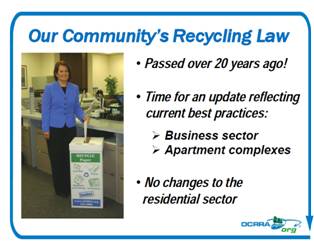 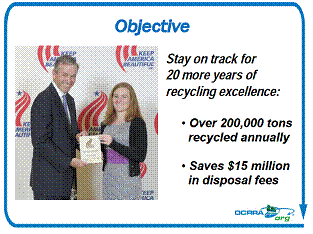
Recycling is a job generator, over 750 jobs connected to local recycling
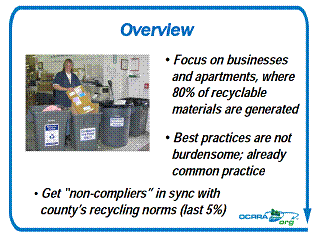 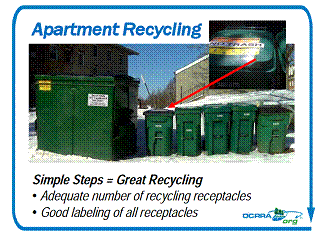
Updates are a powerful way to remind the community of recycling requirements
OCRRA provides decals to haulers, posters to schools and businesses, regularly visits apartment complexes and businesses providing recycling tips
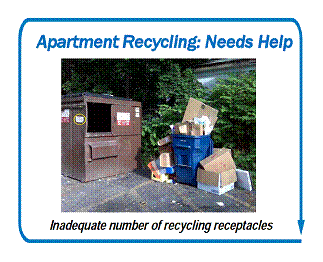 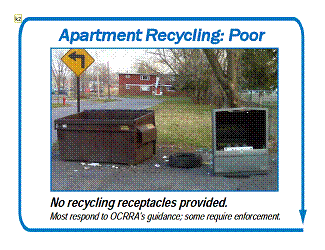
Recycling bins can be procured through the waste haulers or individually purchased
Our population is well versed on what is recyclable
 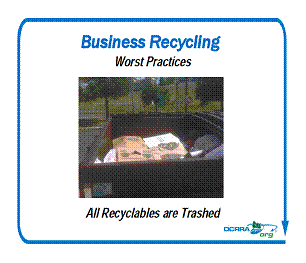
 
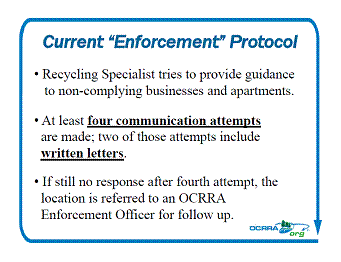 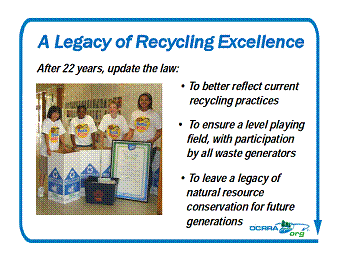
Mr. Radin provided the following information in response to questions:
- OCRRA has developed some public-private partnerships, private entities sort, bail and market the paper
- Contracts with 2 material recovery facilities (MRF’s) for residential recyclables, business relationship insures that residential materials are accepted at the MRF’s for a zero tip, fee regardless of the market price
- If the price is very high there is some revenue sharing, if the price is very low OCRRA provides a little bit of market support
Mr. Buckel stated that the price for recycled paper in China and Asia is very high. He wants to be sure that we were taking advantage of the money making potential, certainly with regards to commercial paper. He questioned if businesses with a recycling practice in place would be affected, with the proposed changes in the law. For example, his office sells their recycled paper. Mr. Radin responded that the only effect the changes would have, was to drive more paper. Chairman Corbett stated that if someone already has a recycling program, this will not change their program.
Mr. Radin confirmed that the proposed changes would not require material to go through OCRRA. There is a strong, stable, long term network of MRF’s in our community. Nothing in the proposed local law would direct where recovered material has to go.
In answer to Mr. Buckel, Mr. Radin stated there is no specific provision that speaks to confidential material. Mr. Buckel stated that their office hired a service to do this, but wondered if this was a service that OCRRA could provide. Mr. Radin responded that there are a number of service providers already doing a great job providing this service. Not only do they provide the shredding, they have worked out a business relationship with the local MRF’s and materials continue to get recycled. Mr. Buckel added that since they are mandating recycling in the commercial setting, they might encounter some resistance from those who feel that they can’t have their business data out there.
Mr. Radin stated that the current twenty-two year old law requires commercial generates to recycle. They are just trying to be a little more specific and detailed with this update. Chairman Corbett added that even though there are provisions in the current law for none compliance, there really isn’t any teeth to it.
- A little less than 20% of the total trash collected is potentially recyclable
- Awareness and opportunity are the key, given the opportunity most will recycle
Mrs. Tassone questioned if businesses and apartments were currently receiving warnings. Mr. Radin responded that the short answer was yes, but they are out there, upfront offering assistance. There are fines in the current law, though OCRRA has never applied a fine. They are not here to say, what we need to do is fine someone. He is going to provide some information on the fines, for their consideration. Legislators as policy makers can decide how they would like to handle this. Any fines that would be applied do not flow to OCRRA; they would go to the enforcing municipality. He believes that they have walked the walk for 22 years. They are not trying to use a stick with the community. Mrs. Tassone added that fines can work as an enforcer. She believes that if a business is going to be fined, you will find that they will put more recycling containers out.
Mr. Radin added that if all the other apartment complexes are practicing good recycling measures, they want to see everyone on the same playing field.
Mr. Radin provided the following information in response to questions:
- No changes for residential generators
-
Fines were revised for commercial generators and waste haulers in 2003; proposing aligning update to 1989 law with provisions approved by the County Legislature in 2003 law
-
Proposed revision for MRF’s, prohibited from taking trash that had been separated from the recyclables and then put back into the recycling stream, once the trash goes to a MRF it is a little harder to insure that it is handled in an environmentally sound fashion
In answer to Mrs. Rapp, Mr. Radin stated the MRF’s are not mixing trash with previously separated recyclables, but they want to ensure that it does not happen in the future. MRF’s business is based on volume. They need to move recyclable materials through their plant to be profitable. If they can offer a service of sorting the trash from the recyclables, they might be able to sell this as an economic benefit to waste generators. OCRRA does not want to see this happen. They do not see this as the roll for private recovery facilities in our community.
Mrs. Rapp stated that she did not see this being in their best interest. She believes that if it was cost effective, they would have already been providing this service. Chair Corbett added that this would be single stream recycling. He believes it would be too easy to let things slip through. Mr. Radin stated that OCCRA was looking for their guidance on this issue, whatever they believe is the best way to proceed. They are just providing some notes for the Legislature’s consideration.
In answer to Mrs. Rapp, Mr. Radin stated that they did not have a timetable. Chairman Corbett added that for those that will not be returning to the legislature, it would nice to get this completed. Mr. Buckel stated that this was important enough to get through this year. Chairman Corbett agreed.
Chairman Corbett stated that he would like comments and suggestions returned to him. He would like to bring the law before the next committee meeting for consideration. The law would continue onto Ways and Means; with completion by the end of the year; understanding that we have budget coming up.
Chairman Corbett added that their input is important as everyone sees things differently. They will collect all the suggestions and comments and come back to committee with a good product. Mrs. Rapp stated she wanted time to speak with some of the commercial companies that are involved, to find out what there opportunities and problems are.
The meeting was adjourned at 10:52 p.m.
Respectfully submitted,
Katherine M. French, Deputy Clerk
Onondaga County Legislature
* * *
COUNTY FACILITIES COMMITTEE MINUTES - AUGUST 11, 2011
KATHLEEN A. RAPP, CHAIR
MEMBERS PRESENT: Mr. Masterpole, Mr. Dougherty, Mrs. Tassone, *Mr. Cox, Mr. Kinne
MEMBERS ABSENT: Mr. Lesniak
ALSO PRESENT: See attached list
Chair Rapp called the meeting to order at 9:00 a.m. A motion was made by Mr. Masterpole, seconded by Mr. Dougherty to waive the reading and approve the minutes of the proceedings of the previous committee meeting; MOTION CARRIED.
1. DEPARTMENT OF TRANSPORTATION: Brian Donnelly, Commissioner
a. Amending the 2011 County Budget to Accept Additional Revenue for Plowing State Roads During the Winter of 2010-2011 ($507,060)
-
Acceptance of additional funds from NYS; County plows 215 miles on behalf of NYS
-
At the end of plowing season, NYS makes a determination of the severity factor – based on total number of miles driven to plow on average across region 3; severity is based on how many more miles above that average was driven
-
Factored to be 1.287 = $507,000
*Mr. Cox arrived at the meeting.
A motion was made by Mr. Kinne to approve this item.
-
State determines the number; take all of region 3: Oswego, Onondaga, Cortland, Madison & Cayuga Counties
-
All miles driven – i.e. 307,000 miles avg. winter (5 - 7 year avg.) – look at previous winter; ask how many miles above or below that average; below: counties held harmless; above: NYS pays severity factor for those who plow miles
-
Currently the County does not do this for the towns but DOT is looking into it; towns have a flat rate – no adjustments
-
The severity factor is protection for harsh winters in NYS – this year is one of the highest numbers
-
Higher number: 2006/2007 season very harsh in Oswego County which raised the severity factor for all of region 3
-
Money is not spent – there are accounts that it will be allotted to
-
Travel and training – meal claims of $7 for individuals coming in prior to their shift; salt
-
Severity factor for 2010/2011 determined after the season; money used towards the next season
-
Average winter; overspend in accounts; use best guess for expense in November and December; extra goes into fund
Mr. Masterpole seconded the motion. Passed unanimously; MOTION CARRIED.
2. ONONDAGA COUNTY PUBLIC LIBRARY: Elizabeth Dailey, Executive Director
a. Amending the 2011 County Budget to Accept State Construction Funds for the Onondaga County Public Library and Authorizing the County Executive to Enter Into Contracts to Implement this Resolution ($377,598)
-
Accepting money from NYS – public library construction; infrastructure project; list by branch; part of capital plan
-
50% match to County – money was previously put in for infrastructure; match from the bonded money
-
Amount for Hazard Branch goes towards not only the fire alarm but restrooms and some towards the elevator
-
Amount shown in backup is the NYS money being applied towards each branch
-
Restrooms are unisex – probably costing $40,000
-
Addressable fire alarm system is in communication with the fire department - if there’s an emergency in the building, the fire department will be notified; Beauchamp Branch is the only one that has used it
A motion was made by Mr. Dougherty, seconded by Mr. Cox to approve this item. Passed unanimously; MOTION CARRIED.
3. SYRACUSE CITY BALLET (UPSTATE BALLET):
a. Informational - Kathleen Rathbun, Artistic Director; Ty Marshal, Development Director; Edward Golash, Board President
Ms. Rathbun stated the Syracuse City Ballet has been in the area for 15 years, and is not in debt.
Mr. Marshal (played short video on Syracuse City Ballet):
-
Referring to attachment no. 1; who we are, history of success, changes and future plans
-
Attachment no. 2 – Single Performance Impact Analysis Estimates: estimated numbers based on audience of 1500 during The Nutcracker - normal 1200-1500; 4 public shows normally
-
1/3 of members having dinner, staying at hotels, utilizing economy
-
Revenue shown is going back to the county for one show; every $1 invested is $7 back to the community
-
Ballet wants to grow as an organization; been in the black for a while
-
Creative fund raising – 2 hour cocktail fund-raiser gained 5 members and $3,000; planning more throughout the year
-
Arts very important for the community; looking for arts to help the economy in Onondaga County
Ms. Rathbun:
- Syracuse City Ballet is a 5013c
- Looking to do a Carmina Burana – a collaboration with the symphony, opera and ballet
Mr. Marshal commented the ballet is also in talks with Philharmonic to collaborate with the Nutcracker; no one else in Syracuse putting on the Nutcracker.
Ms. Rathbun continued:
- Pay rent for county facility: $26,000 = rent and stage hands
- $2,500 currently receiving from County; looking for $30,000; state funding cut; have to make a dollar stretch lately
Mr. Golash:
- Rochester’s Memorial Art Gallery – painting by William Groper (1942); congress debate about public financing for arts
- Portrayal of those opposed was unflattering; the other side won
- WWII – if the USA was going to fight a war, it was for freedom of expression, arts, culture, etc in America
- Moral – not a new debate; do not want an unflattering portrait in 70 years – continue funding arts in Onondaga County
- Thanked the Legislature for having the Syracuse City Ballet
Ms. Rathbun commented that The Nutcracker will be almost all people from Syracuse.
Mr. Marshal:
- 2 months with ballet; floored by what Ms. Rathbun puts the ballet on for; like NYC but achieving at 10th of the cost
- The numbers on attachment no. 2 are all estimates based on top audience numbers for just The Nutcracker
- Civic Center holds 1900 – showing estimate of 1500 for the audience
- Single performance – close to $10,000 revenue based on 1/3 staying at a hotel, parking, dinner, concessions, etc.
- Professional dancers are well taken care of with hotel and food accommodations
- The arts can be an asset; theatre companies seen as an asset when issuing bonds – a building is looked at as a debt
- Trying to reach the suburbs – get involvement from schools in Camillus, Lafayette, Solvay, etc. – come and participate
Ms. Rathbun:
-
People from out of town coming in to see the ballet – i.e.: NYC
-
Working on the ballerina project on Facebook – to promote the ballet, and the city – consists of photo shoots of ballerinas in front of architectural buildings and landmarks in Syracuse; starting Friday at the Everson Museum
Mr. Golash commented the Ballet is in collaboration with the MOST, and will be doing a flash mob on August 19th at 12:30 p.m. to promote the ballet as well as the MOST’s new dinosaur exhibit.
Mr. Dougherty asked what the return on investment would be to the County for funding the ballet an extra $27,500. Mr. Marshal responded the ballet is a local company in the black who wants to grow. The ballet would like to be as well known as the Opera and the Symphony. Ms. Rathbun commented the ballet would be able to put on the production of Cinderella at the Civic Center. She will not allow the company to go into debt so if the funding is not there, they will not be doing the production. Ms. Rathbun continued the more the ballet does, the more people see it, then the more people will become members. Also, more companies will support the ballet and receive more exposure themselves. Ms. Rathbun agreed with Mr. Cox that Cinderella will be put on if they receive the $30,000 they no longer receive from the State. This would generate more revenue for the County plus the ballet would pay rent to the County for the Civic Center.
Mr. Marshal:
- Went from 2 performances of The Nutcracker to 4 – plus 2 school shows instead of 1; goal to have 4 shows a year
- 4 shows with 4 performances each = economic boost; spring, summer, winter, fall
Mr. Kinne commented that the arts are extremely important, and he likes to support them. He confirmed with Ms. Rathbun that the County gives the ballet money, and then charges rent. Mr. Kinne asked why the County charges them rent in the first place. Ms. Rathbun stated the rent is $26,000 including the stage hands. Mr. Marshal responded the rent itself is approximately $3,000 - $5,000 plus union stage hands. Ms. Rathbun agreed with Mr. Kinne, who stated the County should give the ballet $27,000 and not charge rent. Chair Rapp commented it would be up to the Legislature. The Civic Center was built by tax payers, and the ballet is a community group that the County wants to support. Mr. Dougherty responded the issue with renting to the ballet for free, is that the next group to come in would want the same treatment.
Mr. Kinne:
-
It is a good debate; why are the 14 authorized agencies receiving support and no others
-
Always been on the side that it is not right; also agree the Legislature should not be involved in this debate
-
Wants to have an arts organization made up of artists – the artist’s job to put on a show
-
Other communities have this type of organization – don’t get politicians involved
-
Politicians can decide the amount, and who is appointed to the organization; unless there’s a way to raise money, i.e. some communities like Kansas City or St. Louis who have a dedicated fund from sales tax, not positive
Chair Rapp stated there has been a collaborative study done on all arts groups to rate them on effectiveness and return on investment. Mr. Marshal commented the report came out yesterday, and the ballet is on the same tier as the MOST; which is why the ballet contacted the MOST to do the flash mob. The two entities share a lot of the same audience. Chair Rapp stated the study should have recommendations on who is really producing for the community, but the finalized report will not be ready for this coming budget.
Ms. Rathbun asked how to get in front of the rest of the Legislature. Chair Rapp stated there will be minutes. Mr. Kinne replied they should come to budget session in October for the public hearing.
Mr. Cox stated he would support giving the ballet $30,000 based on them putting on Cinderella, and he stated more performances by the ballet will benefit the community.
Mr. Kinne stated in 1993 there was a heated debate about the arts programs. One legislator’s family was a big personal supporter of the Symphony, and wanted to make sure that group kept their funding. Every other program was cut except the Symphony that year. Mr. Kinne would like to dedicate a certain amount of funds to the arts, and let the art community handle it.
The meeting was adjourned at 9:52 a.m.
Respectfully submitted,
Jamie M. McNamara, Assistant Clerk
Onondaga County Legislature
* * *
PLANNING AND ECONOMIC DEVELOPMENT COMMITTEE MINUTES – AUGUST 11, 2011
KATHLEEN A. RAPP, CHAIR
MEMBERS PRESENT: Mr. Stanczyk, Mr. Dougherty, *Ms. Williams
MEMBERS ABSENT: Mr. Cox
ALSO PRESENT: See attached list
Chair Rapp called the meeting to order at 10:30 a.m. Motions was made by Mr. Stanczyk, seconded by Mr. Dougherty to waive the reading and approve the minutes of the proceedings of the previous committee meeting; MOTIONS CARRIED.
1. ECONOMIC DEVELOPMENT: Mary Beth Primo, Director
a. Informational Update: Onondaga Civic Development Corporation; Cultural Resources Trust; Onondaga County Industrial Development Agency – Mary Beth Primo, Director
Chair Rapp stated she has requested this informational update so that the legislature would have time to digest all the information prior to budget; where we are now and where we are headed.
Ms. Primo welcomed the committee and provided them with a tour of the office. She stated that the location was already providing them with dividends. They have joint staff meetings, work together on projects and have a better understanding of each offices mission. Through discussion they know that the city concentrates on some things that they don’t. In some cases they with have different areas and different needs. They have discussed ways in which they can work together on such projects such as the Hancock Airport property. Because they are in the same building, they end up discussing things that they normally would not. This has been very productive.
2011 accomplishments for the Office of Economic Development were provided to the committee. (On file with the Clerk)
Ms. Primo stated she would start by discussing the Onondaga Civic Development Corporation (OCDC). OCDC funds this office and is the organization with the best financial footing.
In response to Chair Rapp, Ms. Primo stated that OCDC pays $115,000 per year to cover the rent and helped to furnish the office. Everyone is pleased with how it turned out.
Onondaga Civic Development Corporation 2011 Accomplishments
Projects:
- Onondaga Community College Housing Development Project – 4585 West Seneca Turnpike
The OCDC authorized the issuance of bonds for the financing of up to $11,000,000 for the Onondaga Community College Housing Development Corporation to renovate an abandoned building on the corner of Velasko Road and Route 173 for use as student housing. There is increasing demand for student housing, and OCC’s existing facilities are at capacity. The renovation enables OCC to meet the needs of its student population as well as return a long-abandoned building to productive use.
Projected fees collected by the corporation: $100,500
Grants/Sponsorships:
ExportNY is a highly successful and long-running program designed to support local businesses in their international business development efforts. When the program’s traditional funding sources were unable to provide their annual grants, ExportNY applied for and received a grant from OCDC to continue operating. ($2,500)
The Americanization League of Syracuse and Onondaga County, Inc. assists the area’s immigrant population with the documentation necessary to work legally in the community and, eventually, obtain citizenship. Unable to obtain county support, the League sought financial assistance from OCDC. OCDC approved a significant grant enabling the Americanization League to continue operating in 2011. ($45,722)
- Brookings Metropolitan Export Initiative & Metropolitan Business Plan
In partnership with CenterState CEO and several other regional organizations, OCDC provided a $75,000 grant to fund initial expenses and committed to a matching grant of up to $50,000 to ensure additional fundraising to support the Brookings Institution’s Metropolitan Business Plan and Metropolitan Export Initiative for the Central New York region. These two programs will provide a customized and comprehensive analysis of the region’s economy, create a strategic plan for regional growth, and recommend a detailed implementation strategy. ($125,000)
*Ms. Williams arrived at the meeting.
Ms. Primo added that they have a few projects in the pipeline. Townsend Towers has already come to the board and provided information on the project. This was held up because of the tax situation. They anticipate this being resolved soon; may close this year or early next year. The other project is a continuation of St. Joseph Hospital which will close in stages; anticipate closing in 2012. They feel confident that OCDC’s revenues will increase.
In answer to Chair Rapp, Ms. Primo stated that FOCUS and Leadership never applied.
Ms. Primo stated that Export NY has been financially supported by OCIDA over the years. Three to five years ago they were getting as much as $15,000 from OCIDA. They came to OCIDA this year with a request for $5,000 because they are really cutting back on expenses, OCIDA agreed to give Export NY $2,500. She asked that they come to OCDC and request the other $2,500. They did and OCDC agreed. She sees this happening more and more. OCDC will start supporting the programs that OCIDA traditional had but is no longer able to do.
In answer to Mr. Dougherty, Ms. Primo stated that they are looking at international exports.
Total Grants/Sponsorship Expenses: $173,222
Other Achievements:
2011 Projected Revenues: $100,500
2011 Projected OED County Contract Expense: $125,197
2011 Projected Operating and Program Expenses: $123,222
Projected 2011 End of Year Cash Balance: $819,000
Onondaga Civic Development Corporation |
819,000.00 |
Projected Cash Balance at end of 2011 Fiscal Year (December 31st) |
(168,465.00) |
2012 Budgeted Onondaga County Contract Expense for Administrative Services |
(237,936.00) |
2012 Budgeted Operating and Grant program expenses |
1,200,000.00 |
*Projected Project Fees for 2012 |
1,612,599.00 |
Approximate Cash Balance at end of 2012 Fiscal Year |
* 2012 Project fees estimate based on closing the remainder of the St Joseph's Project and Upstate's Townsend Tower project |
Chair Rapp stated that there had been talk about the City looking to establish its own OCDC. Ms. Primo stated they have established their own local development corporation. She has been having conversations with Mr. Walsh so that they can work together and not steal from each other. Chair Rapp added that they don’t want to compete with each other for the business they are in. Ms. Primo agreed and added, perhaps driving the fees down. She stated that the County Executive has talked to the Mayor about this as well.
Ms. Primo stated that she went to Upstate to encourage them to come to OCDC to fund the Townsend Towers and Harrison Street projects. They said they had heard good things about doing projects through OCDC but they also knew that the city was getting involved in these sorts of projects. She suggested that since they had two projects that were both about the same amount ($20-$25 million), they give one to the County and one to the City. The Townsend Towers project was brought to them as they are up and running. She is not sure if they will bring Harrison to the City or not, she anticipates that they probably will.
Ms. Primo added that the County Executive has assured the Mayor that these fees are not being used just to help areas outside the City. For instance, it is paying for this office which is a benefit to the both the County and the City. The Mayor along with the County Executive encouraged OCDC to support the Metropolitan Business Plan. The support given to the Americanization League certainly helps both City and County residents. Everything they are doing is beneficial to everyone within and outside of the City.
Chair Rapp asked if the City contributed to the support of this building. Ms. Primo responded, “No”. Chair Rapp asked if this would change with the development of the LDC. Ms. Primo stated that OCDC graveled with this when they were asked to fund the entire lease. They had heard that the City was creating their own LDC and questioned why they couldn’t contribute once they were up and running. In the end it was decided that we should not look at this as City – County. This is OCDC’s project, helping out the entire County. The City is within and an important part of the County. She would imagine that if OCDC were to run into financial difficulty and the City LDC was healthy and up and running, perhaps they would look to them for support.
Mr. Stanczyk stated that the City forming its own LDC is problematic. Both of these projects are located in the City. It is not a problem if they are able to work together and we don’t see future projects located within the City all going to the LDC. Chair Rapp added that we would be paying the bills and they would be getting the cash. Mr. Stanczyk stated it would be problematic if these two organizations were set up as competing rather than complimentary. The fact that they are starting their own LDC sets the tone that we are not able to work together. Mr. Dougherty questioned why they would want to set up their own LDC. Mr. Stanczyk replied income and control.
Ms. Primo stated that OCDC is paying for this office. This is a conversation and she and Mr. Walsh have been having, as well as the County Executive and the Mayor. They don’t want to get into this situation. It is not a problem at the moment. They are having conversations about it to determine how this can be done. Perhaps in a year or two it may be that they have one LDC with the City and County both having a say in. For the moment, with the work that OCDC is doing, they are not leaving the City behind. They are making everyone feel a little more comfortable.
In answer to Mr. Stanczyk, Ms. Primo confirmed the $406,401 listed is the budget for 2012. Chair Rapp asked if the $168,465 covered salary expenses as well. Ms. Primo stated this figure was for contract expenses of administrative services, she would not call this salary. It covers a portion of the expenses for her office related to the OCDC
The OCDC Economic Growth Fund
Mission & Purpose
The Mission of the Onondaga Civic Development Corporation (OCDC) is to stimulate economic growth through facilitating investments that will promote job creation and retention, improve the quality of life of Onondaga County citizens, generate prosperity and encourage economic vibrancy, and lessen the burden of government for Onondaga County as a whole.
The Corporation’s primary function is the issuance of bonds for not-for-profit organizations located in Onondaga County. With income generated from the issuance of bonds, the Corporation is proud to give back to the community through its Economic Growth Funding.
General Guidelines
The Corporation’s primary goal is to offer assistance to those projects and purposes that will affect the economic position of the County and for which financial support typically is not available from other public, community, or foundation funds.
In all instances, the Corporation will fund only projects that directly impact the businesses or residents of Onondaga County. The Corporation encourages a qualified applicant to review its funding request directly with Corporation staff before formally seeking funding from the Corporation. The Corporation will not support any unsolicited proposals sent to the Corporation through the US postal services, electronic mail or package delivery. The Corporation will not fund organizations that are considered by the federal Internal Revenue Service as being tax exempt for religious or political purposes.
OCDC Funding Programs
Economic Development Loans: Based on the availability of funding and at the discretion of the OCDC Board of Directors, the OCDC will participate in economic development loan funds, managed by an Onondaga County-based business development corporation that has a demonstrated, successful history of underwriting and managing economic development loan funds in Onondaga County.
OCDC funding is restricted to loan funds that provide gap financing to net-wealth generating companies or companies that produce a value-added product or service in Onondaga County. Priorities will be given to loan programs that fund companies that have had initial market success but lack the private capital and equity necessary to accomplish a significant corporate goal.
The specific terms of the OCDC participation in any loan fund will be negotiated with the business development corporation. In all cases, however, the business development corporation must agree to provide the corporation with the purpose, recipient and amount of each proposed loan prior to issuing the loan.
The OCDC Board reserves the right to entertain proposals that request the Corporation’s participation in a loan fund that serves other purposes on a case-by-case basis.
Business Attraction and Retention Grants: Based on the availability of funds and at the discretion of the OCDC Board of Directors, the OCDC will consider incentive grants to significant business attraction projects that are considering a relocation of a facility located outside the five-county Central New York area to a location in Onondaga County. The Corporation also will consider incentive grants to retain those projects considering relocating an Onondaga County-based facility to a location outside the five-county Central New York area as well as to projects that will significantly expand a company’s presence in Onondaga County.
The terms and amount of a grant will be determined by the Board on a case-by-case basis, based on a cost-benefit analysis that considers the type of firm, the number and quality of jobs to be created or retained in Onondaga County, and the project’s potential long-term impact on the economic base of Onondaga County. In all cases, however, the qualifying grants will be extended to value-added and/or net-wealth generating businesses as part of an integrated attraction or retention proposal developed totally or in part by the Onondaga County Office of Economic Development.
Economic Growth Grants: Based on the availability of funds and at the discretion of the OCDC Board of Directors, the OCDC will fund the study and/or implementation of strategies and/or projects that will have a measurable impact on the community in which the project is located and a resulting impact on the economic base of Onondaga County. In all cases, the OCDC will support only those projects managed by a nonprofit corporation that is positioned for success as demonstrated by a solid case statement, an experienced governing board and management team, and the staff resources necessary to complete the project within a timeframe identified in the case statement.
Preference will be given to proposals requesting funding not readily available in the CNY community and/or proposals that leverage funding from other public or private organizations. The OCDC will negotiate the parameters of its support on a case-by-case basis but, in all cases, OCDC funding will not be released until the applicant has secured all funding necessary to complete the project.
In answer to Chair Rapp, Ms. Primo stated the guidelines listed above were adopted by the Board about two months ago. They have been working on them all year.
Trust for Cultural Resources of the County of Onondaga 2011 Accomplishments
Projects:
- Syracuse University Project- 621 Skytop Road, Syracuse
The CRT authorized the issuance of $47,670,000 of tax-exempt bonds for a Syracuse University capital improvement project. The project involves major maintenance and capital construction needs for numerous Syracuse University facilities, site work, and utilities for the fiscal years 2011-2014.
Total fees collected by the Trust: $238,350
Grants:
- IDEAS Collaborative – $50,000 for Phase II and $100,000 committed and reserved for Phase III
The Trust for Cultural Resources of Onondaga County is a major funder of the IDEAS Collaborative. The project is an effort led by local philanthropic agencies to enhance audience participation and identify growth sectors for Onondaga County’s cultural institutions. Currently IDEAS is working with more than 40 local arts organizations on specific audience development recommendations. In the next 6 months IDEAS will introduce a redesigned marketing effort, including a collaborative marketing website, and create a grant program for specific audience development initiatives.
- Authorized Agencies - $202,248
At the request of the Onondaga County Legislature and as part of the CRT’s continuing mission to support, promote, and protect Onondaga County’s cultural, educational, and historical organizations, the CRT provided one-time grants to 10 organizations traditionally supported as Authorized Agencies in the Onondaga County Budget.
- CNY Jazz – $7,200
- Cultural Resources Council - $54,078
- Redhouse - $13,500
- Salt City Playhouse - $10,121
- Skaneateles Festival - $5,076
- Syracuse International Film Festival - $19,800
- Syracuse Opera - $55,320
- Syracuse Stage - $23,022
- Upstate NY Ballet - $2,880
- Baltimore Woods Nature Center - $11,250
Total Grant Expenses: $252,248
Process/Program Achievements:
Trust Challenges:
- Statutory Limitations
- Can only bond for cultural and educational not-for-profit organizations that have been in existence for more than 5 years.
- With limited potential projects and significant demands on its eligible grant funds, the Trust faces a significant cash balance issue in 2012.
2011 Projected Revenues: $238,350
2011 Projected OED County Contract Expense: $77,213
2011 Projected Operating and Program Expenses: $269,441
Projected 2011 End of Year Cash Balance: $331,700
Mr. Stanczyk asked if the Skytop project was for housing. Ms. Primo responded that it was all sorts of things. It may include Skytop, but is all the maintenance and capital improvement projects that they foresee for the next three years.
Chair Rapp questioned why the $238,350 was not 1% of the project. Ms. Primo responded that they have oversight from the State Comptroller, who pushed for a lower fee. She added that there is only one other trust in NYS and they are located in NYC. When they take on a project the fees they generate are only used for administration. They have never used the fees they way that we do, they don’t collect fees beyond the administration costs. This is what the Comptroller’s office was concerned with. For the first project we charged them .75%. For this project, after being pushed by the state, they charged .50%. She believes this will be the fee for future Syracuse University projects, due to the oversight of NYS. Chair Rapp stated this was new, from the way this was present originally. Ms. Primo responded that it was not what they had anticipated charging.
Ms. Primo added that the CRT felt strongly about supporting the IDEAS Collaborative to assist in making these organizations self sustaining. They can’t be dependent on the government and CRT.
Ms. Primo stated the CRT does not have any projects in the pipeline for next year. The challenge she faces with this organization is that although it has the ability to do civic facility bonding, this can only be done for arts and cultural organizations with an entity that has been in existence for over 5 years. This is where they are running into problems. OCC, LeMoyne and SUNY ESF projects could not be handled through the CRT, as all of these projects were done by a single purpose entity, created specifically for the project. Other than Syracuse University, she does not know where CRT will get future projects from.
Chair Rapp stated that it seems as though it would be in there best interest to go through the CRT for the lower fee. Ms. Primo stated that this was not public knowledge. They did not have a problem giving them a lower fee as these projects are so large, however if everyone started coming to the CRT she believes they would give more push back to the state about this. Syracuse University was their first project. They now feel more confident that they could push back with the State.
Trust for Cultural Resources of the County of Onondaga |
331,700.00 |
Projected Cash Balance at end of 2011 Fiscal Year (December 31st) |
(68,234.00) |
2012 Budgeted Onondaga County Contract Expense for Administrative Services |
(116,968.00) |
*2012 Budgeted Operating and Grant program expenses |
146,498.00 |
**Approximate Cash Balance at end of 2012 Fiscal Year |
* The Trust has reserved $100,000 for Phase III of the IDEAS Collaborative |
** In January 2011, the Trust resolved to suspend all grant giving if the Trust's asset balance is $150,000 or less. |
Mr. Stanczyk questioned how they could justify the administrative services fees for 2012 without any projects. Secondly, he understands that they gave $100,000 to the IDEAS Collaborative but questioned what the other $17,000 listed was for. Ms. Primo responded this was for legal expenses, insurance, and auditing expenses. Mr. Stanczyk added that this was operating expenses and questioned how they justified $85,000 out of this small pool of money for their office, when they did not foresee anything coming through.
Ms. Primo stated the CRT is able to pay and believes they should pay, for our office administrative expenses. These are determined by looking backwards and figuring how much time was spent on each board. They have spent a lot of time on the CRT in the last 10 months. The guidelines are now in place for awarding grants, and they don’t have many funds. They will not be putting a lot of time into the CRT next year, without a project. When they forecast the budget for 2013 she anticipates that CRT’s contribution to their office will be much less.
Mr. Stanczyk responded that this money is for arts and cultural organizations and you are using it up in administration fees for an economic development function. Other than board meetings, there is nothing going on. This does not make since to him. Mr. Primo stated that this amount is being driven by what happened over the last year. She questioned where the money would come from if they did not charge the CRT. Chair Rapp suggested they get the funds from OCDC, who is flush. Mr. Stanczyk stated that in terms of fairness there are two different organizations and the CRT is for arts and cultural things. Taking economic development funds from the CRT seems wrong.
Ms. Primo added that the $68,000 is fair, looking back over the time that they have put into this. Mr. Stanczyk stated that this doesn’t make since. Budgeting looks forward, you would charge for the amount of time you anticipate spending in 2012. He does not know that you should charge administrative and operating costs to this fund. He would take more of the position of the state. The state believes we should be providing an enabling method for organizations to get to the bond markets as cheaply as possible. What we are doing is actually charging a fee above and beyond the actual expense and using some of these fees to offset our economic development expenses. He believes if we are going to raise the money from them, the funds should be spent on the arts and cultural organizations. Ms. Primo added that this is the opposite of what the state is telling them. The state has no problem with them paying administrative costs. They don’t support collect a fee above and beyond the administrative cost and use it to pay out grants.
Mr. Stanczyk stated that in January you established that CRT will not award any grants if they have less than $150,000 and then you get to the point where you have just under this amount.
Mr. Dougherty left the meeting.
Ms. Primo asked why this board should not have to pay administration costs when all the others boards do and the trustees are willing to do so. Chair Rapp responded that arts and cultural organizations are going to need operating funds. We are funding administration fees instead of the arts and cultural organizations.
Mr. Stanczyk stated he can understand the grant ward to the IDEAS Collaborative. We are trying to give them the mechanism to become more self sufficient. However when you then charge them administrative expenses, he has a concern. Chair Rapp added especially when there is not actually any administration going on because there are no projects. Ms. Primo responded that they have put more work into the CRT this year than the $68,000 they are charging. This is 9% of their budget. Compared to what the other boards are paying and the amount of work that was put in for CRT, this is a bargain for them.
Mr. Stanczyk stated they are government employees who were getting paid; they were just trying to reallocate the expense. He has a problem with them reallocating the expense against an arts organization. Ms. Primo stated they do not anticipate receiving any local dollars for their budget in 2012 and doesn’t believe that they did for 2011. Mr. Stanczyk suggested that they get the funds from OCDC. Ms. Primo added that OCDC would have to agree to this.
Ms. Primo stated that they will have the same issue with OCIDA, as their revenues are trending downward. This is a direct result of them not having the authority to issue bonds for things that are now going to OCDC. Chair Rapp added that we have taken one board and divided them among three boards. Ms. Primo agreed.
Onondaga Industrial Development Agency Accomplishments
Projects:
- SYSCO Foods – 2508 Warners Road, Town of Van Buren
SYSCO Syracuse LLC is a Texas-based food distribution company with regional distribution facilities located throughout the United States. The Project consists of the construction of a 96,000 sq. ft cold dock facility, 6,600 sq ft of mezzanine space, the renovation of a 67,000 sq ft freezer, and the conversion of a 41,000 sq ft cooler to a dry storage warehouse. Total project cost is estimated to be $20,112,887, which includes $11,317,000 of construction costs, $7,387,887 for machinery and equipment, $1,144,000 for site work and $164,000 for engineering costs. Agency benefits will include a PILOT and an exemption from sales and use tax. SYSCO Syracuse LLC expects to retain 475 full-time equivalent jobs.
- Aspen Dental/Pemco Group Inc – 6600 Weighlock Drive, Town of Dewitt
Aspen Dental Management, Inc. is a dental practice management organization operating throughout the United States. The Aspen Dental/ Pemco Group has 2 projects; the first consists of the construction of 46,626 sq. ft. building to be located on 3.3 acres at 6600 Weighlock Drive in the Town of Dewitt. The facility is an expansion the company’s operations located on Sanders Creek Parkway. The new facility will be used for training, administrative offices and as a call center. The total cost for this project is $7,262,055 and includes $900,000 for land, $4,566,609 for construction and $983.015 for site work. The second project consists of the acquisition and installation of office furniture, fixtures and equipment for the facility located at 6600 Weighlock Drive, Dewitt, as well as the equipment and back-up generator for the facility’s computer server room. The total project cost is $1,210,000. Aspen Dental currently employs 174 employees in Onondaga County. The project will create 126 new jobs with an average salary of $32,000 over a three-year period. Agency benefits will include a PILOT, an exemption from sales and use taxes, and a mortgage recording tax exemption.
- Tessy Plastics- 7528 State Fair Blvd., Town of Van Buren
The Tessy project will transform 75,000 sq. ft. of existing warehouse space at its North Plant, a portion of the former Syroco facility, to an automated assembly operation for one of the company’s most successful products, Old Spice underarm deodorant containers. The estimated project cost is $1,815,000, which includes $300,000 for building renovation, $1.5 million for machinery and equipment, and $15,000 for other costs associated with the project. Agency benefits are an exemption from sales and use taxes. The Company employs approximately 730 full-time employees. Twelve full-time employees will be moved from the Elbridge plant to the Van Buren plant and the company anticipates adding 25 to 30 employees with an average salary of $41,000 by year-end.
- Welch Allyn 4341 State Street Road, Town of Skaneateles
Welch Allyn develops and manufactures medical devices and related products. This project consists of the renovation of approximately 36,000 square feet of space located in the corporate headquarters and manufacturing facility, 4341 State Street Road, Town of Skaneateles. The renovation will house offices and research facilities associated with the corporate R&D and Products Development departments. The total project cost is estimated to be $5,000,000 and includes $3,069,000 for construction costs and $1,653,500 for the purchase of equipment. Agency benefits include an exemption from sales and use taxes. The Company has approximately 1216 employees and expects to add 13 employees with an average salary of $61,000 over the next three years as a result of this project.
.
- AAA Western & Central New York, Inc 6601 Towpath Road, Town of Dewitt
AAA of Western and Central New York is expanding its regional headquarters, currently located on Henry Clay Boulevard in the Town of Clay, to include a new facility located at 6601 Towpath Road in the Town of DeWitt. The new facility will house the fleet administrative services and its fleet dispatch center. The project consists of the acquisition of equipment and furnishings for this new facility. The existing facility will continue to accommodate the company’s customer service call center. The Company has 63 employees in its Central New York location. The project will retain approximately 22 dispatch associate positions locally, which otherwise could be handled remotely. The approximate project cost is $235,000.
Projected fees collected by the agency: $389,565
Employee Productivity Program (EPP) Grant Awards:
Total Employee Productivity Grant Awards: $74,560
- Bluepoint Environmental LLC - $6,090
Bluepoint Environmental is a full service indoor environmental quality-consulting firm that offers a unique multidisciplinary approach to diagnosing and resolving air quality problems in residential and commercial properties. Bluepoint Environmental LLC requested Agency assistance for its training plan. The training will distinguish Bluepoint from its competitors by bolstering its professional credentials and techniques. The company expects to increase total employment by eight FTE over a three-year period after the training is completed.
Ultra Dairy, an affiliate of the Byrne Dairy Corporation, is a manufacturer of extended life dairy products. The company employs 122 full-time employees. The EPP grant will assist in implementing a training plan to improve the skills of its four Maintenance Mechanics. OCM BOCES will provide the training.
Tessy Plastics Corporation is a local company that provides precision custom injection molding services. The Employee Productivity Grant will train a minimum of five employees in Level 1 and Level 2 Flow & Warp Analysis (CAD software). Benefits to Tessy include proficiency in CAD software that simulates complex molding operations, reduction in the time it takes for a tool to be designed, lowering the costs and increasing the chances of securing new business
- Rapid Response Monitoring Inc. - $12,500
Founded in 1992, Rapid Response is an alarm monitoring company with customers located throughout the United States. The company employs 384 full-time and 40 part-time employees at its headquarters located in Franklin Square, City of Syracuse. Rapid Response has built its business by providing its customers with high quality, dependable, 24/7 customer service. This grant will support training to improve the supervisory and management skills of its corporate managers.
- Specialized Packaging - $12,500
Specialized Packaging Group founded in 1983 and merged with PaperWorks Industries in 2008 creates reliable, consistent packaging that reflects brand values while meeting the toughest requirements for strength and durability.
The Employee Productivity Grant will train 12 employees in the technology associated with new printing equipment.
JR Clancy is one of the oldest and largest manufacturers of stage rigging equipment in the world. It currently employs 58 full-time employees. The EPP grant will ensure the company is operating as efficiently as possible. The Company will train key employees (minimum of 21) in the effective operation of a new Enterprise Resource Planning (ERP) system as well as continue its lean manufacturing and productivity improvement training project begun last year.
- Oneida Air System - $12,500
Oneida Air Systems manufactures a wide variety of standard and custom dust collection systems, sold to customers in the US, Europe and Asia. The company employs 42 full-time employees. The company, which holds numerous patents, proactively adapts its product to meet customer demands or to create new market opportunities. The EPP grant will assist the company in developing lean manufacturing and productivity improvement strategies to help eliminate waste from its process, improve employee performance, and maintain its competitive edge.
- Tony Baird Electronics - $1,970
Tony Baird fabricates and inspects reliable solderless connections, interconnecting cables and wire harness assemblies for space flight hardware and critical ground support equipment. The company is embarking on a growth plan and strategic alliance with a local manufacturer. The EPP grant will allow Tony Baird to train two of the company’s key employees in leadership and process skills necessary to support the successful implementation of the alliance.
Sponsorships:
Total 2011 Sponsorships: $5,500
- WISE Symposium
- Accelerate Regional Tech-Development Conference
- FOCUS Wisdom Keeper II Event
Process and Program Achievements:
- OCIDA implemented a Green PILOT program, which improved and streamlined its previous Green PILOT Tax Credit.
Agency Challenges:
- OCIDA has faced decreasing cash flow since 2008 when state IDAs lost authority to issue civic facility bonds.
-
Agency response: In an effort to stabilize cash flow the Agency has continued to trim its budget by reducing expenses. After considering fees charged by other NYS IDAs, the Agency also increased its fees, which had not been increased in over a decade.
- Development of Clay Business Park
2011 Projected Revenues: $287,500
2011 Projected OED County Contract Expense: $297,545
2011 Projected Operating and Grant Program Expenses: $391,022
Projected 2011 End of Year Cash Balance: $1,050,000
Onondaga Industrial Development Agency |
1,050,000.00 |
Projected Cash Balance at end of 2011 Fiscal Year (December 31st) |
(303,238.00) |
2012 Budgeted Onondaga County Contract Expense for Administrative Services |
(289,700.00) |
2012 BudgetedOperating and Grant program expenses |
250,000.00 |
*Projected Project Fees for 2012 |
707,062.00 |
Approximate Cash Balance at end of 2012 Fiscal Year |
457,062.00 |
Approximate Cash Balance at end of 2012 Fiscal Year if there are no projects |

Ms. Primo stated that OCIDA uses more time than any other board. Chair Rapp responded that this was good as they were the private sector. Ms. Primo added that she does not problem with this, however when you look at what they should be paying for administrative services it is more than the other two boards. They are trying to move a little over to OCDC, but they have to be fair to them board as well.
Ms. Primo stated in response to the decreasing cash flow, fees were increased by .25% for projects involving a pilot. This is in line with what other IDA’s are charging. They also reduced their sponsorships. In the past they paid $15,000 - $20,000, this year they paid $5,500. This is another way that OCDC is supporting OCIDA.
In answer to Mr. Stanczyk, Ms. Primo stated that out of the $289,000 budgeted for 2012 operating and grant program expenses, $170,000 is being used to get the Clay Office Park to shovel ready status and $50,000 is for employee productivity. In response to Chair Rapp, Ms. Primo stated that these are various training grants for different companies up to $1,200. The actual operating expense is roughly $58,000.
Chair Rapp asked what was involved with the $170,000. Ms. Primo responded that they have to finish their environmental impact statement. They are now working with Dave Bottar. He has been very successful in brining IDA controlled parcels in surrounding counties to shovel ready status. Mr. Stanczyk questioned if this money would be recaptured as it was being put into the sites. Ms. Primo stated that they hoped to. This property needs sewers and a traffic study, there are also wetlands.
In answer to Mr. Stanczyk, Ms. Primo stated that there is one project in the pipeline. It has been in the pipeline for two years now, it is being scaled back and they are waiting to see. She added that with OCIDA, often times they do not know about projects until they are just about ready to get them. She anticipates that they will have projects next year, just doesn’t know the size or how many.
Mr. Stanczyk stated that Chair Rapp was correct, we used to have OCDA and now we have three organizations. It is better to combine all the cash balances and allocate appropriately the expenses. Ms. Primo stated that she does not have the same board members on each board; it would be great if she did. Mr. Stanczyk added that sometimes you have to deal with what you have. From your projections we will have a larger cash balance at the end of 2012. It is just a matter of allocating the proper expense and knowing if you are making a $170,000 commitment that there is a good economic, business or employment return. Since these boards are approving these expenses; he assumes that Ms. Primo is intimately involved.
Mr. Stanczyk stated will be interested to see how the 2012 budget is presented these organizations. Ms. Primo stated that she was glad he came to the meeting. This is very helpful. She has one board meeting with all three organizations before the budget presentation. She totally understands what the committee is saying; this is why she has already moved things from OCIDA to OCDC. She will discuss with the boards what they can do for the CRT.
Chair Rapp added that they need to be prepared to discuss the cost difference in operating the office here versus within the County Office Building. Ms. Primo responded that they were probably charged less in the County Office Building, but she believes that the current office will pay dividends. This office holds so many meetings; it brings a different level to Economic Development in this area. Mr. Stanczyk stated he believes it is much better off site. Chair Rapp added that the fact that they are not paying market rate rent for this location and some of the things talked about, are good information for people to know.
The meeting was adjourned at 11:15 a.m.
Respectfully submitted,
KATHERINE M. FRENCH, Deputy Clerk
Onondaga County Legislature
* * *
WAYS AND MEANS COMMITTEE MINUTES – AUGUST 12, 2011
CASEY JORDAN, CHAIRMAN
MEMBERS PRESENT: Mr. Buckel, Mr. Corbett, Mr. Lesniak, Mr. Holmquist, 3Mr. Kilmartin, Mr. Warner, 1,4Mr. Stanczyk, 3Mr. Kinne
ALSO ATTENDING: see attached list
Chairman Jordan called the meeting to order at 8:45 a.m. A motion was made by Mr. Corbett, seconded by Mr. Warner, to waive the reading and approve the minutes of the previous committee meeting. MOTION CARRIED.
1. DEPARTMENT OF TRANSPORTATION: Brian Donnelly, Commissioner
a. Amending the 2011 County Budget to Accept Additional Revenue for Plowing State Roads During the Winter of 2010-2011 ($507,060)
- Accept funds from State, based on severity factor from the winter
A motion was made by Mr. Lesniak, seconded by Mr. Corbett to approve this item.
Mr. Lesniak questioned why the State doesn’t set the real rate vs. the County floating them a loan for number of months. Mr. Donnelly said that it is challenging as to how the State calculates their rates. They historically figure out how many miles in an average winter that is plowed; then take a 3, 5, 7 yr. average across the entire region (region 3 – Oswego, Cortland, Madison, Cayuga, Onondaga) that is plowed. The State gives County a lump sum based on State costs, and then for every mile above that they factor in the severity.
1Mr. Stanczyk arrived at the meeting.
In answer to Chairman Jordan, Mr. Lynch said that the State continually adjusts the base amount – done on a 3 year basis.
In answer to Mr. Buckel, Mr. Donnelly said that with these funds the department is expected to be budget positive. It would take an extremely difficult Nov. and Dec. to be in a situation where additional funding would be needed in the 300 line.
2Mr. Kinne arrived at the meeting.
Chairman Jordan questioned how much to the positive the department will be at year end. Mr. Donnelly said that it is challenging to determine how much salt will used; based on weather conditions. He is uncomfortable speculating at this point. From a tonnage standpoint, the average for Nov. and Dec. is 14,000 tons; the amount requested to be accepted today will pay for about 16,000 tons.
A vote was taken on the motion. Passed unanimously; MOTION CARRIED
2. ONONDAGA COUNTY PUBLIC LIBRARY: Elizabeth Dailey, Executive Director
a. Amending the 2011 Budget to Accept State Construction Funds for the OCPL and Authorizing the County Executive to Enter Into Contracts to Implement this Resolution ($377,598)
A motion was made by Mr. Kinne, seconded by Mr. Corbett to approve this item.
- Annual program from NYS; 50% match
- Projects were already in capital project - Grant Infrastructure Project, matching funds are available
In answer to Chairman Jordan, Ms. Dailey said that they had a pretty good idea that they were going to get this grant; there was a lot more asbestos costs than originally projected.
Passed unanimously; MOTION CARRIED.
3. EMERGENCY MANAGEMENT: Kevin Wisely, Commissioner
a. Amending 2011 Budget to Accept Homeland Security Funds From the State Homeland Security Grant Program for the Onondaga Co. Department of Emergency Management, and Authorizing County Executive to Enter into Contracts to Implement this Resolution ($727,388)
A motion was made by Mr. Lesniak, seconded by Mr. Kilmartin to approve this item.
- Will be expended over next couple of years – through July 2013
Mr. Stanczyk asked the Commissioner communicate with the Chairman and committee as to when the money will be spent and for was purpose.
Mr. Warner said that over the years, the Committee has asked for the total expenditure of Homeland Security Funds, and has not received it. He questioned with the federal budget crisis, if the money will come to an end. Mr. Wisely said that they are involved in various grant programs. This State Homeland Security grant continues to be funded going forward; it comes into the State from the Federal government. One grant in the Urban Area Security Initiative has been defunded for a majority of cities in the US, the largest 13 cities. Onondaga Co. still was funded under that program, but there will not be any new funds coming in for it in 2011.
A vote was taken on the motion. Passed unanimously; MOTION CARRIED.
4. SHERIFF: John Balloni, Chief
a. Amend 2011 Budget to Accept State Homeland Security Funds for the Onon. Co. Sheriff’s Office and Authorize the Co. Exec. to Enter into Contracts to implement this Resolution ($281,612)
Chief Balloni:
- Federal Homeland Security money passed down through the State in State Law Enforcement and Terrorism Protection Plan
- Pass through – Sheriff’s office acts as a point to get money and then it is distributed to other police agencies for specific items that they have requested
- Grant to be spent through July 2013
- Training pays overtime cost, not straight time costs, pays FICA and additional cost on overtime
A motion was made by Mr. Stanczyk, seconded by Mr. Lesniak to approve this item.
In answer to Mr. Lesniak, Chief Balloni said that grant funding has been utilized a number of times over last several years to get ballistic vests. Some have been grant funded, some have been budgeted. Mr. Lesniak asked if grants are being submitted for vests now. Chief Balloni didn’t believe that right now there are any open applications for grants. Different grants have different life expectancies; are looking for a grant for CERT extrication team in the Custody Division; do not have current funding for those vests.
Chairman Jordan asked, given this grant money, where the department anticipates being at the end of the year regarding the budget. Chief Balloni noted that the grant money has been coming in regularly and doesn’t anticipate that it will substantially change the year end numbers. The grant was anticipated when the budget proposal was submitted last year.
Chairman Jordan referred to consolidation and shared services, and noted that some town departments are getting SWAT vests; he questioned if this is a duplication of services; do towns need separate SWAT teams. Chief Balloni said that the logic is that it takes some time to get a SWAT team together – some members are on the road working; some have to be paged from home. A local agency may see the value in having a local, smaller group that they can get together quickly. At minimum cooperation amongst the SWAT teams would be very good. Chairman Jordan asked if efforts have been made to integrate or dovetail the town activities with the County. Chief Balloni said that the training is for both; there are attempts at dovetailing. Chairman Jordan asked if there have been discussions with towns to restructure it to provide the service more cost effectively. Chief Balloni said that the towns know that they have full access to Sheriff services; there is talk about working together, but not about consolidating.
A vote was taken on the motion. Passed unanimously; MOTION CARRIED.
Mr. Kinne noted that at Public Safety Committee, there was discussion about the Sheriff selling naming rights to Air 1; he questioned if the County Executive is aware of it and if the Sheriff has the power to do this, as it is owned by the taxpayers. Chief Balloni said that the suggestion of naming grants came from the legislature. Mr. Kinne said that he would like to know the answer prior to budget time. Mr. Fisher did not know if the County Executive is aware of it. Mrs. Tarolli said that the Law Department will look into it.
Chief Balloni reported that the Sheriff’s Office was notified yesterday that the DEA had awarded $20,000 to offset expenses this year. They have also applied for funding for next year to offset expenses.
5. WATER ENVIRONMENT PROTECTION: No department representative present
a. Authorizing Acceptance of Grant Funds from NYS Environmental Facilities Corporation Green Innovative Grants Program and Authorizing Execution of Grant Agreements to Implement the Intent of this Resolution ($712,500)
Mr. Corbett:
- $712,500 grant – green initiative – War Memorial arena rainwater reuse
- County has to spend the money and get reimbursed
Mr. Stanczyk asked to be provided with an estimated cost of maintaining the equipment to process the water from the roof and put on the ice.
A motion was made by Mr. Corbett, seconded by Mr. Lesniak to approve this item. AYES: 8 (Corbett, Lesniak, Holmquist, Kilmartin, Warner, Buckel, Kinne, Stanczyk); NOES: 0; ABSTENTIONS: 1 (Jordan). MOTION CARRIED.
6. LEGISLATURE:
a. Calling for Public Hearing on the 2012 County Budget
A motion was made by Mr. Lesniak, seconded by Mr. Warner to approve this item. Passed unanimously. MOTION CARRIED.
7. WAYS & MEANS, MISC.:
a. Approving an Alternative Allocation of Payments in Lieu of Taxes for Anheuser-Busch, Incorporated, Pursuant to General Municipal Law §858(15) (Sponsored by Mr. Lesniak)
Mr. Lesniak reported:
- The reason this has to come to the legislature is because it is a disproportionate PILOT agreement.
- Each district tried to work out the number of taxes that they could live with, not necessarily the assessment number
- County – year 1 - $300,000 is based on $75 million for everyone; number starts to modify in year 2
- A lot of discussion with Anheuser-Busch since takeover of In-Bev--all plants are in a competitive mode amongst themselves.
- There was a tax certiorari, which settled on the $75 million – there was an agreement that a PILOT would be worked out
- Started negotiating last Dec., have been meeting with town and school; believes everyone is on board with the numbers
Mr. Warner questioned where this plant stands in regard to all other plants. Mr. Lesniak said that their production did drop because of cost factor on initial tax base; also had a problem with cans. They have re-tooled to go to a 24 oz can, which is a big seller at the sports arenas. They are revising their waste treatment plant, a capital improvement project. The production is starting to increase. He explained that there is an advantage here; we are one of the cheapest plants for water. New Jersey has been shut down the last couple of months because they have been unable to get water due to drought. .
A motion was made by Mr. Warner to approve this item.
Mr. Corbett pointed out that besides the regular employees at Anheuser-Busch, they maintain an almost constant construction work force, which employees all local workers. Mr. Lesniak noted that Gypsum Express is their main hauler.
Mr. Lesniak seconded the motion.
Mr. Stanczyk said that the assessment was dropped from $95 million to $75 million. Mr. Lesniak agreed. Mr. Stanczyk questioned what happens if they leave in two years; Mr. Lesniak said that there is a claw back. Mr. Fisher explained that the current taxes are about $460k for 2011; the $300k represents a significant cut on the town side. The certiorari settlement took the assessment from $95 million to $75 million on January 1st. The County tax roll that went to Anheuser Bush was about $460k. The year one is the school year 2011-12; it is the County’s 2012. The town is on the $75 million assessment the first year. This is an unusual PILOT; it is a consent PILOT. In a consent there can be a disproportionate share; the county is taking a larger cut.
Mr. Stanczyk asked that the numbers be run for the 15 years - total how much each locality is giving up. Mr. Fisher said that the tax rates are not known. Mr. Stanczyk said that he wants to know what the concession is for each. Mr. Buckel explained that in year one the County, at $75 million assessment, would be receiving $460,000, and is taking $300,000; it is less as time goes on. Mr. Fisher said that when the $250,000 level is reached in year four; it is about the equivalent of a $40 million assessment. At the same time the school will be down to about a $67 million assessment; town will be down to a $65 million assessment.
Mr. Stanczyk asked what is the important year for In-Bev. Mr. Fisher said they hired Anheuser Busch Inc; there was an agreement that out of the 12 North American breweries, none would close before 2014. This is a 15 year PILOT; they are making a commitment for 15 years; there are very significant recapture clauses that are in the process of being negotiated with OCIDA, which would possibly have to approve the recapture, and Anheuser Busch. Mr. Stanczyk asked if this passes and they close in 2015; will the County recapture what it going without for the 4-5 years. Mr. Fisher said that he thinks the County will capture a significant portion. Mr. Stanczyk wants to know that there is recourse. Mr. Fisher said that before the legislature votes on this, the school board will have the last, best and final offer, which will include nailing down the recapture. He is hoping that the town board will act and that Anheuser Busch will agree to the offer. In answer to Mr. Stanczyk, Mr. Fisher said that the school is giving up more dollars; the county is giving up more percentage of its dollars. Mr. Lesniak said that the school board is scheduled to meet on Monday; the town is scheduled to meet on the 22nd. The County will be the final approval; the resolution is contingent on the other two entities.
Mr. Buckel said it looks like a $3 million cost to the County over the life of this; overall for everyone about $5-$6 million. Mr. Lesniak said that he was in the ball park. The school district and town was concerned about planning; so there was an effort to make the first 3 years as flat as possible and then make the drops, which would give everyone time to plan. Mr. Buckel said that the assumptions are based on the assessment staying flat and the tax rate stays flat. Mr. Lesniak agreed.
Mr. Warner questioned what the financial loss would be to CNY if AB decided to pull out, if this was not passed. Mr. Lesniak said just right around AB, Gypsum Express is the main hauler, that company in itself is tied to AB. Mr. Warner said that millions and millions of dollars would be lost to the is community. In answer to Mr. Kilmartin, Mr. Lesniak said that AB has over 400 employees right now. Mr. Lesniak added that there is a constant construction work force in there all the time also.
Chairman Jordan asked that the language in the resolution be enhanced regarding the justification for doing this. Mr. Lesniak said that he has spoken to Law Department about it. Chairman Jordan said that he will support this today, but he wants to see the PILOT agreement prior to supporting it at session. Mr. Lesniak said that the only thing absent from this is the claw back, which will hopefully be done before session.
A vote was taken on the motion. AYES: 8; NOES: 0; ABSTENTIONS: 1 (Buckel). MOTION CARRIED.
8. FINANCE:
a. Informational – Debt Position – James Rowley, CFO
Mr. Rowley:
Mr. Rowley distributed information (Attachment No. 1). Chairman Jordan stated that the information must be presented prior to the meeting; and it won’t be allowed in the future.
In answer to Mr. Kilmartin, Mr. Rowley noted:
- Ratings are set once/year
- Ratings now: Fitch is AAA with stable outlook; Moody’s is AA1; Standard & Poors is AA+ with stable outlook
Mr. Rowley continued:
In answer to Chairman Jordan, Mrs. Tarolli stated that she will look into why ACJ is excluded in the formula for debt margin.
Mr. Rowley continued:
- 2nd page is current and future debt plus what has been set aside to borrow into future
- Outstanding debt – bonds issued principal not paid on it yet - $262 million serial bonds; $160 million ERC loans in WEP
- $739 million in debt – either under management now or will potentially be issued in the future, which principal will be paid on
- General fund debt – assumed approx. a $3 million RBD
- A lot of RBD used in WEP
In answer to Mr. Lesniak, Mr. Rowley noted that if Van Duyn were sold, the County would still have the debt.
Mr. Rowley continued:
-
There is debt for E-911 that is not offset directly; but feed their budget about $3 million in surcharge revenue – offset their debt cost for radios
-
Hillbrook debt – get 50% state reimbursement – revenue in their budget, not specifically in debt service fund
-
Projection of general fund debt service - assumes going to market for $30 million/year in new debt – will come from authorized and unissued as well as any new debt authorized between now and years on the forecast
-
Working on projection for WEP
In answer to Mr. Stanczyk, Mr. Rowley indicated that at the end of any typical year, the debt is reduced by approximately $30 million principal. Mr. Stanczyk said that basically $30 million is paid off and about $30 million new is put on – about status quo in not adding debt. Mr. Rowley said that it does grow, because when debt is put on, principal isn’t paid in the first year – just pay interest.
Mr. Kilmartin said that it looks like over five years that debt is popping from $21 million to $34 million. Mr. Rowley agreed and said that he wants to look at this further; it may not be a one for one because for the speed of debt being issued in WEP is picking up because deadlines are coming for ACJ. For a short term, may see a blip and then it will come down. Mr. Kilmartin said that WEP is excluded, and still seeing a fair amount of growth over the next five years. Mr. Rowley pointed out that principal is being reduced too. Mr. Kilmartin asked if the net debt service line reflects that in 2011 – 2015, debt is being retired – is the principal reduction embedded. Mr. Rowley said that it is embedded in the numbers. Inside a debt issue, 5 year, 10 year, 15 year, or 20 year bonds are issued. It is not a straight amortization schedule. His projection is that net debt service over the next 4 or 5 years will gradually increase, assuming the County issues $30 million in new debt every single year, which may or may not be true.
Mr. Corbett referred to the fiscal agent fees; it was determined that there was an error on the spread sheet. (Mr. Rowley provided a revised sheet to the Clerk following the meeting – included in attachment no. 1).
Mr. Buckel noted that this is the kind of report that he has asked for every time the County borrows; it is very useful. He asked about the reference to policies, which are noted on the first page; questioned if they are legislative policies or executive policies. Mrs. Tarolli said that she will look into it. Mr. Seitz noted that a lot of the policies are in the annual budget in the debt service section. Mr. Stanczyk said that a lot of the rating agencies have policies that they want us to adhere to. Mr. Buckel stated that the rating agencies aren’t a policy making and budget setting body. Mr. Rowley noted that the reports are critical to the rating agencies. They feel that the County manages its finances well and fund balance is more and more important in this environment.
Mr. Kilmartin referred to a significant escalation in the Transportation forecast, and asked if specific projects are anticipated. Mr. Rowley said that they did a mini catch up with DOT with issuing bonds the last time they went to market. Bonds are authorized in the work plan; have worked with DOT to see how they will spend it; if the authorization lags behind, then they will encourage the department to spend it, which is when the bonds are issued. Another factor in terms of the variability is that the legislature has authorized issuance of another $317 million in debt and the timing of the cash flow of it impacts debt service. There are projects behind all of the numbers.
Mr. Rowley continued – reviewed last page:
-
Once bonds are sold, receive a set of reports – this one is one of the most important
-
Par amount of bonds issued = $33,755,00; $36,696,003.40 cash took in for par amounts
-
$2,658,085.85 net premium – goes into reserve for bonded debt – that is how reserve for bonded debt accumulates
-
Net interest cost (NIC) 3.1% - a simple calculation, not used anymore
-
True Interest Cost (TIC) 2.953% - how bidders are evaluated, a more refined calculation, iterative – true interest cost paying on the issue after the premium
Chairman Jordan asked what determines the premium. Mr. Rowley said it is driven, to a large extent, by the County’s rating. There were seven bidders on the last issue and the winning bid was JP Morgan.
Mr. Stanczyk asked what happens with net premium; Mr. Rowley said it goes into reserve for bonded debt and stays on the balance sheet and then is bled into debt service. Mr. Rowley answered that they have gotten premiums the last two times he went to market. The reserve for bonded debt as of today is about $12 million. To manage it, so it doesn’t become a structural thing by taking it all in one year, they try to bleed $3 - $4 million a year into debt service; exhaust it over a 3 year period.
Mr. Stanczyk said that 2.95% is an unbelievable rate; should be borrowing as much money as possible. It makes sense to do long-term borrowings and not short-term borrowings now. He is curious about the reserve for bonded debt -- wants to have more discussion about how it is bled in.
Mr. Buckel referred to capital expenses, and said if there is a chance to look forward more than we already are 5-10 years and implement a major capital, this is the time to do it. Mr. Stanczyk agreed and noted that it would stimulate the local economy by providing the impetus for more jobs by taking on more projects.
3Mr. Kilmartin left the meeting.
Mr. Rowley said that they are looking at capital investments that will vent the operating cost curve going forward, i.e. put in new windows in Civic Center to cut heating costs, it is a good investment.
b. Informational – Auction Process for Delinquent Tax Properties – Mali Tarala, Real Property Tax Svcs.
Ms. Tarala distributed the following schedule:
ONONDAGA COUNTY DELINQUENT TAX AUCTION
Crouse Hinds Theatre
Tuesday, October 25, 2011
8:00 a.m. – 4:00 p.m.
SIGN-IN 8:00 A.M.
January 21 Run Advertising List
January 28 Notices Sent To Delinquent Property Owners
April 18 Title Searches
April 25 Six Month Notices to Property Owners – regular mail
April 25 Six Month Certified Mailings to Owners & Occupants
April 25 Six Month Certified to Lien holders
April 25 IRS, State Tax Commission, Commissioner of Labor & NYS Franchise Tax
June 27 Four Month Notice - regular mail
July 11 Process Server
August 8 List to Auction Company – Start Nail & Post
Sept 11 First Ad for Newspaper
Sept 18 Second Ad for Newspaper
Oct 17 Finance Department Inspection
October 25 Auction
Ms. Tarala noted:
Mr. Stanczyk asked if there are more than 300 properties that could be taken to the process; Ms. Tarala said she would report back with an answer.
Ms. Tarala continued:
- Sheriff’s Department is the process server – a huge stimulant for the delinquent owner
- There about 147 homes in this auction, which is high; there are 26 commercial properties on the list
Mr. Stanczyk asked how much is owed on the 300+ properties; how much comes in at every step. Ms. Tarala said that she can provide the information. She noted that on the 326 properties that they have right now, there are $4.4 million stilled own on them. So far $1.7 million has been collected on 260 of those parcels.
In answer to Mr. Kinne, Ms. Tarala said that all properties sell at auction – everything goes. The County takes the highest bidder; very rarely does the bid go below the amount of taxes that are owed. She noted that last year 87 parcels sold at auction; the bids totaled $880,000; $79,000 was the buyer’s premium (9% that he auctioneer gets), leaving $811,000.
Mr. Stanczyk asked to be provided with detail from last year – identified number of properties, amount owed, how much was paid going through the process; how much back debt was extinguished through the auction – how much was owned and how much taken in. Ms. Tarala said that $2.3 million was collected; $405,000 was financed through delinquent installment payment plan; $190,000 net proceeds after outstanding taxes were paid. Mr. Stanczyk asked how much indebtedness was there starting out. Ms. Tarala noted that Mrs. Carney could provide that information. Mr. Stanczyk asked to be provided with a spread sheet of the details from last year.
Mr. Buckel said that numbers have importance long term as we look at the possibility of a land bank. One consideration to look at is to see whether the process of acquiring tax delinquent properties will yield either as much or more money; change the history - typical tax sale of a property there is a spiral to the misuse and non-payment continues. The land bank is designed to turn them into productive uses.
Mr. Lesniak asked if there is an interdepartmental chargeback for the Sheriff doing the process serving. Mr. Rowley did not think so.
Mr. Kinne asked if a property sells, and it is a wreck, then the buyer decides he/she can’t use it; is there follow up as to whether it comes back on line. Ms. Tarala said that she would see it back probably within four years, but they do not keep track of it. In answer to Mr. Lesniak, Ms. Tarala said that she can see the history by address on the computer in the paid file, if a property had been to an auction before. Mr. Lesniak said it would be interesting to know how many properties are reoccurring.
Mr. Kinne asked if Ms. Tarala is saying that no property is deemed uncollectable; that they will eventually collect. Ms. Tarala agreed. Mr. Kinne asked if there is a better way to deal with the 200 or so properties that are taken off the list each year. Ms. Tarala said she would welcome input. Mr. Kinne feels it needs to be looked at; even if the property has to be given away, it is better than keeping it on the books. Ms. Tarala said that she has been trying to get a resolution process in place for these types of parcels. Chairman Jordan asked if those property owned by the county. Ms. Tarala said “no” they belong to whoever is the last one in title. Chairman Jordan said that perhaps there should be a tax sale which includes those parcels; if they don’t get sold the County takes title, and then the County can dispose of them in some fashion. Ms. Tarala said that there may be liability involved. Mrs. Tarolli said that she will look into. Mr. Seitz expressed caution in taking title to properties, may want to do an environmental look; have been reluctant to take over titles of some properties. Chairman Jordan said that the county may defacto own the property anyway if no one wants to own it.
Mr. Stanczyk reiterated his request for last year’s numbers and noted that the County does not make more than 100% of taxes collected; the number is in the budget every year.
4Mr. Stanczyk left the meeting.
9. LAW DEPARTMENT:
a. Settlement of Litigation
A motion was made by Mr. Corbett, seconded by Mr. Lesniak to enter into executive session to discuss pending litigation entitled “C.O. Falter Construction Company V. County of Onondaga. Passed unanimously; MOTION CARRIED.
A motion was made by Mr. Corbett, seconded by Mr. Lesniak to exit executive session and enter regular session, noting that no action was taken during executive session. Passed unanimously; MOTION CARRIED.
The meeting was adjourned at 10:33 a.m.
Respectfully submitted,
DEBORAH L. MATURO, Clerk
Onondaga County Legislature
* * *
HEALTH COMMITTEE MINUTES - AUGUST 16, 2011
ROBERT WARNER, CHAIRMAN
MEMBERS PRESENT: Mr. Meyer, Mr. Holmquist, Mrs. Ervin
MEMBERS ABSENT: Mr. Laguzza
ALSO PRESENT: See attached list
Chairman Warner called the meeting to order at 10:11 a.m. A motion was made by Mrs. Ervin, seconded by Mr. Warner to waive the reading and approve the minutes of the proceedings of the previous committee meeting; MOTION CARRIED.
1. HEALTH: Linda Karmen, Deputy Commissioner
a. Amending the 2011 County Budget to Accept New York State Division of Criminal Justice Services Aid to Crime Laboratories Funding and Authorizing the County Executive to Enter into Agreements to Implement this Resolution ($100,000)
-
$100,000 grant: provides support to forensic toxicology lab – compliance with American Board of Forensic Toxicology; managing case work, testing requirements, maintenance of equipment for processing labs
-
First time applied for particular grant; eligible when toxicology lab switched from lab services to MEO
Dr. Morrow:
- The switch is not a budget line change; change of function of the lab to the MEO
- Under the MEO, the toxicology lab was eligible for the grant; application process started in May
- Changes in state aid – MEO funding cut drastically; grant used to offset some; some for costs not relating to operation
- $400,000 needed for rest of year – total for 2012 is $800,000; working with budget to handle shortage
Mrs. Karmen responded to Chairman Warner that aid to the lab has been around a long time, and the forensic lab has taken advantage. Mrs. Rooney replied to Chairman Warner there probably is a list of grants somewhere. Currently she receives notices when funding is available. Whoever is presenting the grant will send out a general email across the government when they are announced. Each department will have someone monitor these and apply to whichever grant is pertinent. The Health Department has been very successful, and normally when they apply for a grant, they receive it. They are working hard to find grant money to make up for the loss of funding for the MEO. Dr. Morrow commented she receives notices daily about grants but eligibility is another question; the department is not eligible for most. Mrs. Rooney continued they are very careful in decision making for when to apply for grants. In 2009, they made a conscious decision to apply for a grant, applied and received the grant. She replied to Chairman Warner they are almost perfect.
Mr. Meyer stated it is very difficult for the MEO to absorb $400,000 so he assumed they would look outside the MEO to the Health Department. He asked, with 4 months to go, when will they propose adjustments since it is not within the $7,500 limit. Chairman Warner responded Mr. Rowley stated in the last meeting they would find it. Dr. Morrow replied to Chairman Warner it is being dealt with at the Budget level, not Health Department level. Mr. Dean stated Budget is looking at the 3rd quarter forecast to see how big of a hole there is. Mrs. Rooney said Mr. Rowley will present a transfer but there is no schedule at this time.
A motion was made by Mr. Warner, seconded by Mr. Meyer to approve this item. Passed unanimously; MOTION CARRIED.
b. Amending the 2011 County Budget to Accept NYS Division of Criminal Justice services Paul Overdell Funding and Authorizing the County Executive to Enter Into Agreements to Implement this Resolution ($60,235)
Mrs. Karmen:
- $60,000 – appropriations granted to MEO; quality assurance and improvements, timeliness, elimination of back logs
- Used for vacant administrative aid job – quality assurance reviews; necessary for N.A.M.E.
Dr. Stoppacher:
- Paul Coverdell was a US Senator; passed away
- Federal grant was part of his legacy to provide a substantial amount of funding for forensic science to reduce back logs; cannot be used to cover operating expenses
Mrs. Karmen responded to Mrs. Ervin the department will continue to apply for the grant, but when the funding for the 12 months is over, the position will be eliminated.
A motion was made by Mrs. Ervin, seconded by Mr. Warner to approve this item. Passed unanimously; MOTION CARRIED.
c. Abolish RP 01 404300 2212 Typist I, Grade 3 @ $27,653-$30,511, effective September 30, 2011
- Result of reduction of funding in Childhood Lead Prevention Program; used as an opportunity to reassess program
Chairman Warner commented it is good to abolish the position because of the lack of grant funding. Mrs. Karmen responded to Mr. Meyer the position is occupied, and will include a lay off. The department is trying to look to find other duties but nothing determined as of yet. The person is aware the position is being eliminated.
A motion was made by Mr. Warner, seconded by Mr. Holmquist to approve this item. Passed unanimously; MOTION CARRIED.
d. Informational: S.U. Maxwell School Report – Mandatory, Non-Mandatory Programs
Dr. Morrow:
-
Attachment no. 1; report done by 6 grad students; time intensive effort; worked with Health Advisory Board
-
Program analysis of the Health Department; original presentation to Health Advisory Board done in June
-
Presenting their presentation – disclaimer: initial study has been altered; grammatical errors and some changes
-
Three program changes: grant programs (physical activity or nutrition programs) - 2 are program mandated but downgraded to essential; one optional but all three do the same so to keep consistent put the optional to essential
-
In their own words; page 5 – read paragraph just before disclaimer; took out program specific numbers
-
Analysis done at the Maxwell School under the guidance of Tom Dennison, Ph.D.
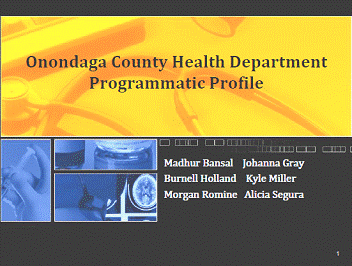 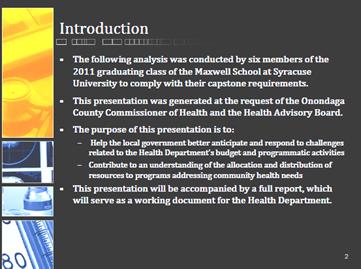
- Page 5 of attachment no. 1 – overview of classifications
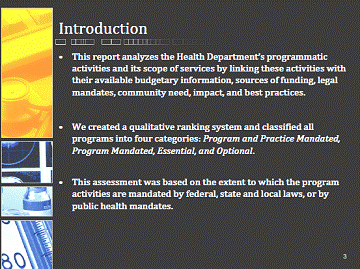 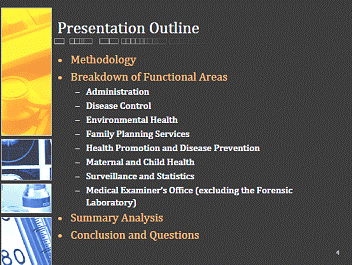
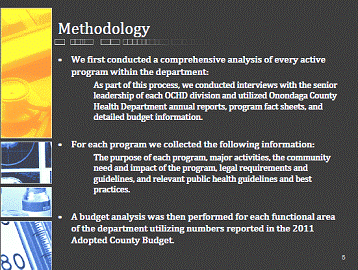 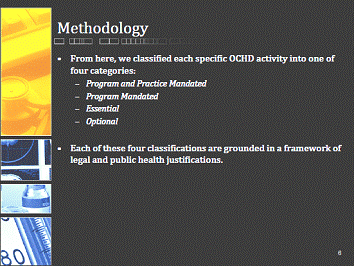
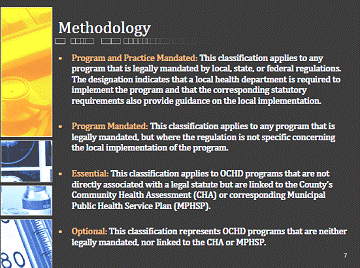 
 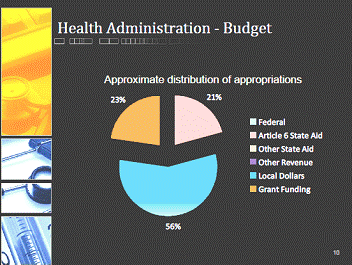
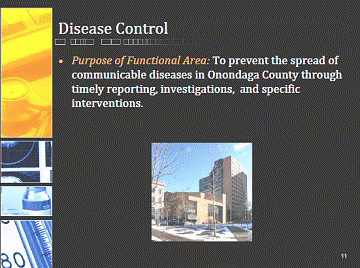 
 
 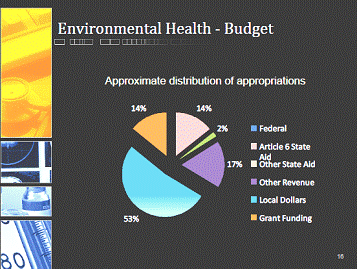
- Table of contents on page 3; page 53 – 59: local laws, summary of programs, public health guidelines
- Program level data not available; cannot replicate the numbers – currently working on it case by case
- Mandated information by program on page 59
Chairman Warner stated the question will be what is mandated, and out of the mandated programs, how much is paid for by the state, federal government versus local dollars. Dr. Morrow responded, in general the mandated programs will receive 36% state aid; the County owes $.64/dollar cost of the program. Dr. Morrow responded to Chairman Warner all of the 64% is mandated. For example: Vector Control, talking about Triple E; the County is required to do some level of surveillance, but it is clearly a county benefit. The State says you’re required to do it, it is your county but the State will give $.36 back.
Mr. Meyer asked if Monroe County would have the same pie chart if they were to do this study. Dr. Morrow replied she cannot answer that but would expect it would be the same.
 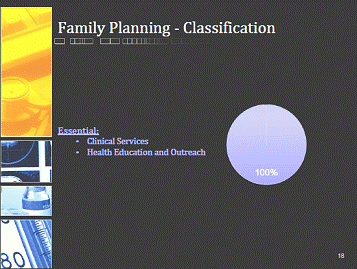
 
 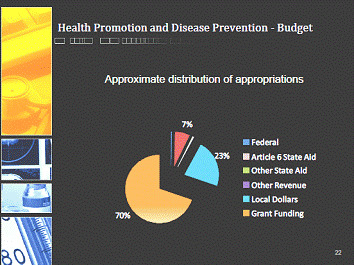
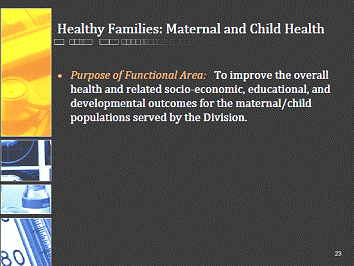 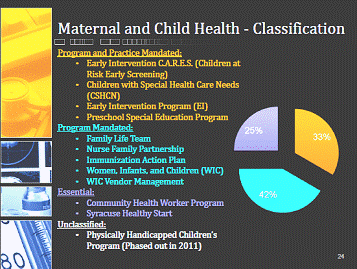
 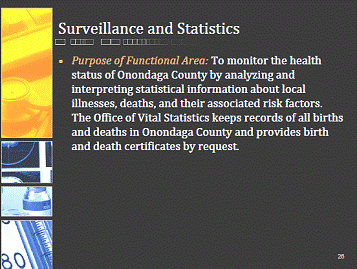
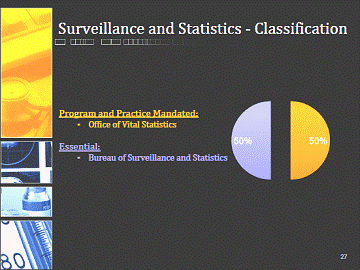 
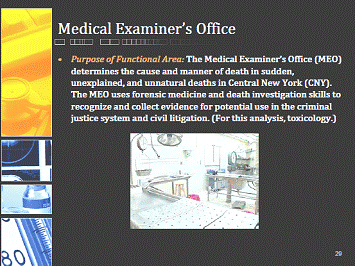 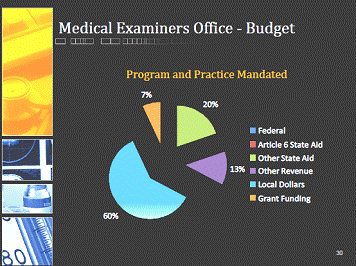
 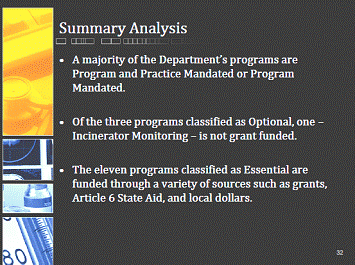
 

- 50% mandated – 38% local dollar cost
- Required to do 50% by number of programs not by scope – includes EI and Pre-K – required at federal level
Chairman Warner asked what 38% amounts in the budget. Dr. Morrow replied it will be available at budget. Mrs. Wilson responded to Chairman Warner that the reimbursement for EI and Pre-K is 59.5%; 40% local. Dr. Morrow responded the total budget is $46 million. Chairman Warner commented he has a better understanding. He said the report stemmed from last year’s budget where some Legislators felt the Health Department had programs above and beyond what was mandated and necessary. He believes there may still be questions of whether the County can cut some of the programs that are mainly local funded. Dr. Morrow responded the summary pages will be very helpful, and in the 2012 budget, she will weave this reporting in as much as possible. The Health Department now has an independent party that came and looked at the legal background. The report has the entire section and sub section of where it is required by law so anyone can see it.
Dr. Morrow:
- Extremely valuable resource – complex, received emails at 3 a.m., students did 24/7; worked 4 weeks straight
- Yes there are mistakes but complexity makes it more difficult to be perfect
- Doesn’t get down to what level of service is required – does not address how many environmental sanitarians needed
- Health Department’s job to keep the document updated
- Looking for accreditation next year - strategic planning - important for where to prioritize
- Individual analysis – showing where it is not mandated, not using local dollar; where department gets grant funding
- Times getting tougher – at federal level, down to state, to county – will help to re-strategize program mandates
Mr. Meyer suggested a comparison of Monroe County or Albany County versus Onondaga County. If all the same mandates, compare who’s doing a better job at grants and/or efficiencies; the counties can learn from each other. Dr. Morrow responded she cannot ask Monroe County to engage in the process that took approximately 100 man hours. She will ask Mr. Dennison to see if it is feasible to do another county. Through NYSACHO, they are aggressively trying to share best practices.
Chairman Warner would like to send a letter of thanks on behalf of the Health Committee. He asked Dr. Morrow to contact Darcie with the details.
2. MENTAL HEALTH: Robert Long, MPA, Commissioner
a. Informational: System of Care
- On Care: system of care grant – received in 2009
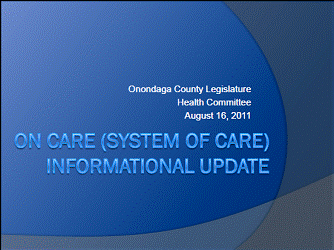 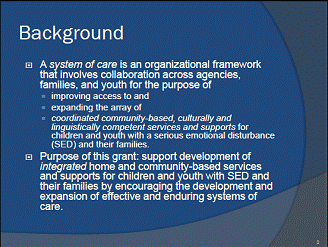
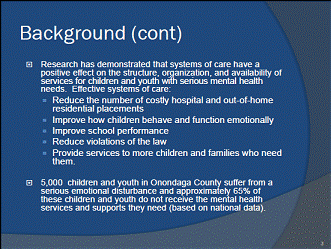 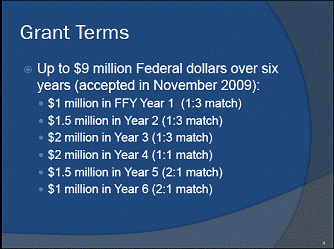
- A child is up to the age of 12; youth is 13 – 18 or 21
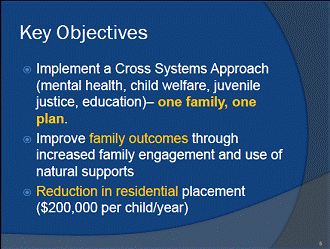
-
$200,000/year – for placement in a state residential treatment center or facility, security detention, DSS
-
The department is looking at how to sustain the program after the grant is done
-
DSS and child welfare – joint project
-
Challenges in system; 2 silos based on ages – treat as kids up to 16 or 18; treat as adults after 18 or 21
-
Systems that serve 0 – 16 and a different system for 16 - 21
-
16-22 – moving from being kids to adults; same challenges plus serious emotional disturbance; more challenges
-
DSS has approximately 60 kids in placement - not all at that cost, some higher or lower; Mental Health has 40-45; Secure detention has 5 or 6; totaling around 100
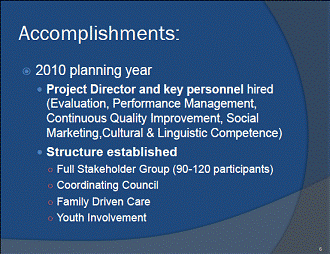 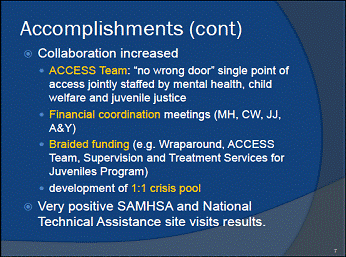
Mrs. Rooney
-
Linda Lopez – Project Director, comes with experience from Salvation Army and Rescue Mission; national recognition attributable to the departments collaboration and her leadership; very pleased to have on board
-
There is an individual plan for every family
-
Conferences in Chicago in July; Legislature would have been proud
-
4 occasions, the department had to present the grant they had for only 2 years
-
Key component is working with the judges of Family Court; families drive the work, judges see the families and it helps in their decision making
-
Judge Hanuszczak and Judge Walsh Hood very intimately involved - plays very well to national recognition
-
When Judge Hanuszczak walked into a room at the conference, he received a standing ovation
-
Very proud of the way Onondaga County is being looked at
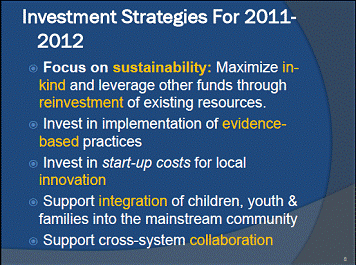 
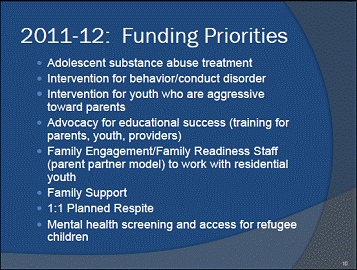 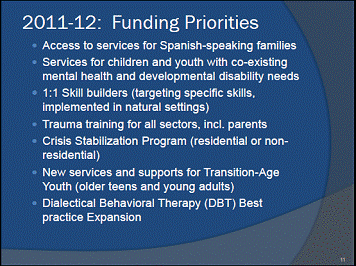
Chairman Warner commented it was a good presentation. It is an eye opener of the work and effort going in. Mrs. Ervin stated it makes sense to look at the total picture to help the families. Mr. Long commented the departments in DSS see the children as all of their children. The same child can be cross to different systems. Mr. Long responded to Chairman Warner the grant does run out in 2015.
3. SOCIAL SERVICES: David Sutkowy, Commissioner
a. Informational: Daycare
-
Handout on file with Clerk
-
Talking about daycare subsidy program; not asking for anything; Daycare program: situation; actions intending to take
-
5 big benefit programs: welfare, Medicaid, food stamps, energy assistance and daycare
-
Daycare: provides financial support to qualifying parents to pay for child care; $18-$19 million annually; 3,500 kids
-
Daycare shifted over years – daycare was attached to welfare program; provide services for families within welfare
-
Handful in child welfare who access benefits; now daycare more attached to welfare than child welfare
-
Provide subsidies to welfare recipients who are working or in work preparation program; need access to daycare
-
Testing: household income – determine eligibility, if eligible, then provide subsidy to help with costs
-
Our job is not just to determine eligibility – higher mission; job is to help get families and kids out of poverty
-
Everything done hinges on economy changes
-
Father worked after WWII – blue collar laborer, worked there for 30 years, work quit him when it moved to South America; quit working at that time, still had health care – bell shaped curve economy is not existent anymore
-
Now – higher number of service jobs, high number of professional jobs, low number of manufacturing jobs
-
Service jobs don’t provide wages or benefits to help families get above poverty level
-
Took responsibility for welfare – looked at welfare grant, what their life would be like if they were working
-
Society is pushing people to work but may not be financially beneficial – the types of jobs available did not help families to get out of poverty – they were not better off working
-
Participate in work prep program and get a job, become self supporting – ought to help with transitional benefit
-
Federal government measures by federal poverty level; NYS child poverty level at 12.3%, Onondaga County at 12.9%
-
False measure; not measuring other kinds of support the household has access too – i.e.: earned income tax credits, energy assistance, food stamps, daycare - this will raise earnings higher than poverty level
-
National Academy of Science – alternative poverty level that looks at expenses, income, other income available
-
State poverty rate goes from 12.3% – 12.9%, Onondaga County goes from 12.9% – 7.7%
-
Onondaga County has lowest child poverty rates in the state – able to dramatically impact child poverty
-
Framework for programs; higher mission – help families get kids out of poverty - daycare an essential element
-
Couple years ago, may have problems; receive bulk of funding – federal and state dollars; have been able to live within appropriations – low income rising, child welfare lowering
-
Expenses rising – may have to ask for local dollars or restrict eligibility; many counties have restricted eligibility
-
Did not have to ask for anything then recession hit – welfare up, caseloads up - people losing jobs
-
People graduating from jobs plus employment effort – not working as many hours as before so despite increases in minimum wage, the household earnings are not as high as 5 years ago
-
Daycare costs rising – federal subsidy money under ARRA; $1.5 million – money is now gone
-
Now looking expenses being higher than income – cut costs or increase revenue
-
Cutting costs – discharging current recipients; 3,500 receive subsidy – 1,000 would have to be removed in 2012
-
Still crunching numbers and scouring budget – $2 - $4 million to balance budget
-
I.e.: eliminate daycare subsidies for someone working who has 4 kids and cannot afford childcare; they come back into the welfare program, go through the work program and then get a job, just to be denied benefits
-
Don’t know a way around it; other counties gone through before - restricted eligibility, Erie removed 1,000 kids
-
Managed allocation very well but economy changed dramatically; not asking for anything, crunching numbers
-
Not a problem for today but will be in 2012 – advance of budget presentation in September
-
Loss of federal subsidy money in the amount of $1.5 million – why the amount for budget went up - local funding
-
For future years, no clue of appropriations; hard to predict economy; welfare cases stabilizing; is economy improving?
-
Families that may get cut: some return to welfare; care supported is regulated - some informal providers; more than not are leaving regulated care and buying care cheaper
-
Scenario – Mom and 2 kids; gross $2,000/month; child care requirement of $118; net household income is $1800; lose subsidy (probably would not qualify) - daycare goes to $1100 – net would be $848/month; would receive increase food stamp but still $600 short from previous earnings
Chairman Warner asked if 1,000 families are cut from daycare, would there be increased costs in other areas. Mr. Sutkowy responded there will be some migration to other programs, i.e. welfare, and he will try to get a projection within the next month.
Mr. Sutkowy:
- Want people to work; welfare a dead-end, institutional poverty
-
Put a financial package together including earnings, health insurance, earned income tax credit, daycare, etc – now have financial way to make it
-
Wrong to take credit in child poverty rate – the department and the County do a very good job to help low income families access the benefits
-
Owed it to committee to have a discussion prior to budget
-
Looking for $2 - $4 million but not coming up with solid number until need to; looking at everything to adjust
Mr. Sutkowy introduced Eva Kerznowski who is the new director for temporary assistance, food stamps, daycare and energy assistance. Eva has been with dept for 34 years and is replacing Steve Seifritz; retired.
The meeting was adjourned at 11:51 a.m.
Respectfully submitted,
Jamie M. McNamara, Assistant Clerk
Onondaga County Legislature
* * * |



























































